#best dry white wine for french onion soup
Explore tagged Tumblr posts
Text
Website: https://www.wineterroirsandtales.com/
Address: Noisy le Roi, France
Wine Terroirs & Tales is an independent wine blog by Adrian Latimer, who has cherished wine, its stories, travels, and tastings for over 40 years. Born in '61, Adrian's journey with wine began unexpectedly during his student years. In 1991, he moved to France, a haven for wine enthusiasts, and later married Kathy, who had ties to the wine trade. Adrian's writings, primarily on travel and fly-fishing, took a turn towards his passion for wine upon his early retirement in 2020 from the insurance/oil sector. The blog is a reflection of his personal experiences, opinions, and tastes, aiming not to instruct or profit but to share his love for wine and offer readers a delightful experience.
Instagram: https://www.instagram.com/wineterroirsandtales/
Keywords: wine enthusiast best red wine best non alcoholic wine best white wine best sweet red wine wine enthusiast wine cooler best cheap wine best red wine to drink best sweet wines best red wine for cooking best port wine best wine for mulled wine best wine for thanksgiving best cheap red wine best italian wine best wine gifts best wine with steak best electric wine opener best non alcoholic wines best red wine vinegar best sparkling wine best tasting wine best wine clubs wine enthusiast wine fridge best french wine wine travel bags enthusiast wine travel wine glasses wine tasting experience wine enthusiast gifts best french red wine wine enthusiast wine rack best french white wine travel case for wine travel wine bottle protector best french wine regions best wine tasting experience in napa wine sleeve for travel
#best french white wines#food and wine travel#wine carriers for travel#best french red wines#best french rose wine#unique wine tasting experiences napa#best dry white wine for french onion soup#best french bordeaux wine#food and wine travel tours#travel wine bags#best napa wine tasting experiences#wine tasting experience at home#best wine tasting experience#cheese and wine tasting experience#experience wine tasting#luxury wine tasting experience#online wine tasting experience#unbiased wine reviews
1 note
·
View note
Text
Come the warm, ripening days of summer and I imagine that I am closer to a more ancient, basic and healthful style of vegetable and grain eating than in my cold and meaty winters. I am seduced by my garden and neighboring farm stands vivid with color and flavor.
I avoid a lot of hot time in the kitchen. Much is eaten raw or almost: vegetable soups - gazpacho has many names and many recipes - vegetable sauces for rice or pasty and endless salads. I have corn on the cob and other vegetables in every form: grilled, roasted, steamed, stir-fried, puréed and combined in a variety of stews to be eaten hot, cold and at room temperature. Fresh herbs, garlic, onions and imagination sauce the dishes. The first beans from the pod or dried beans, fruit, cheese, bread and wine complete my menus.
There is almost no meat and little chicken or fish - an occasional grilling, a stew more vegetable than meat, a slice of cold meat or charcuterie, a boiled egg, a little tuna from the can.
I eat this way for pleasure as well as in a modern quest for a more healthful diet. Those came before us ate this way to take advantage of what they had - often limited. While we tend to see a cornucopia-vision of the past, rich in more seasonal, more natural foods, it is only partly true.
Winter in most climates was short of fresh vegetables, and the world relied on salting, pickling, drying and cold storage for any vegetables at all. The animal protein we are fending off today was in short, expensive supply.
With the best will in the world and without an evil intention, food writers and the natural inclination of all of us to glamorize the past and the far away have been guilty of distorting our view of the way the world eats. By selecting the best, the most festive food of other places or times, we have come to see them as halcyon visions of plenty, filled with meat and seafood, sugar and cream.
It is not sugarplum fairies, but roasts and fries, sausages and sautés, stews and cassoulets that frolic in our Rabelaisian dreams. Southern picnics are enriched with baked hams and fried chicken. Clambakes clutter the shores of a mythical New England. In that world of the imagination, native Africans are awash in chicken and ground-nut stew, native Americans feast on venison and buffalo, Greeks expand over countless dishes of succulent lamb, the Chinese are exquisite in damask while dining on unimaginably choice viands.
The English eat hearty roasts, silken salmon, and mountains of oysters. The French of the mind are various, either robust peasants glorying in rich stews or jeweled aristocrats whose famous chefs set forth succulent sauces. Our Italians live in a world of perpetual holidays, their risotti topped with pungent white truffles.
While not totally untrue - these foods did exist in each of these countries and were eaten by the natives at least upon occasion - such visions falsify the totality of real experience and may contribute to the glut of fat and cholesterol in our lives. We equate these festive foods with good living and think that ,if we can, we should eat this way all the time.
Our ancestors and many peoples all over the world today eat very differently from this skewed perception. Carbohydrate, or stodge, was what really fed and filled up most people. With bread as the staff of life in Europe, scarcity led to bread riots for centuries. Even in the recent past, when the government-fixed price of bread was raised in France, the announcement was carefully scheduled for August when almost all Frenchmen are on vacation.
Certainly, the staple food of the vast majority of the world is still rice, followed by bread and potatoes along with noodles - pasta among them - soy foods, yams, taro, yucca, corn, beans, pulses such as lentils, myriad grains and other starchy foods with names foreign to me. In the past and in much of the present, animal protein, when available, has been primarily a flavoring.
Beasts were not killed promiscuously. They were the cash crops and the providers of the milk and eggs. If a pig was slaughtered in the fall, that was a major event, and a family would hoard the preserved hams for Christmas and Easter, or sliver small amounts for a taste at many meals. A prosciutto bone or other ham bone was an asset to be used and reused in soups until flavorless. Fresh meats were rare; only the overage animal or the single, religiously festive springling was sacrificed.
To envisage a chicken in every pot was to dream of luxury indeed - the most luxurious of Sunday dinners.
if other meats were salted and smoked like bacon, or pickled like corned beef, air-dried like grisson or jerky, or preserved in fat like confit, it was to keep them over the winter and dispense them parsimoniously as special treats.
So when we read recipes for peasant dishes crammed with meat, we should remember we are reading about rare treats, not daily fare. Even fishing nations could have uncertain catches, rough seas and months when it was impossible to put out upon the water. Even plenty might need to be sold. A home-cooked paella was mainly rice, seasonings, oil and vegetables.
The great go-along-withs have been vegetables and fruits, fresh when in season, pickled or preserved for inclement times. A little fat would have come from the possibilities of each region - olive oil, butter and lard. Food was about survival and pleasure when possible. No one got more than nutritionally sound share of meat and fat over the course of a year. It is these daily recipes that are by and large missing or recorded primarily as accompanying dishes in our cookbooks and kitchens.
It is up to us to re-create out of our plenty the sane eating and pleasures that scarcity and invention, herb patch and garden, bestowed on our forebears.
"The Real Past", from The Opinionated Palate: Passions and Peeves on Eating and Food by Barbara Kafka
8 notes
·
View notes
Photo

French Onion Soup with Homemade Beef Stock Recipe The best homemade beef broth for French onion soup is used in this recipe to create the authentic French onion soup. Fortunately, you can prepare the broth in advance and, if you prefer, use a slow cooker. 4 large onions thinly sliced, 2 tablespoons dry sherry, 2 carrots peeled and coarsely chopped, 1 teaspoon salt, 1/4 cup dry white wine, 1/4 cup flour or more as needed, 3 parsnips peeled and cubed, 4 thick slices French bread, 1 pound beef short ribs, 12 cups water, 1 teaspoon freshly ground black pepper, 2 bay leaves, 1 teaspoon chopped fresh parsley or to taste, 1 teaspoon chopped fresh thyme or to taste, 1 dash hot pepper sauce or to taste, 1 teaspoon herbes de Provence, 1 tablespoon fresh thyme, 3 onions coarsely chopped, 1/4 cup butter, 3 cloves garlic smashed, basil and garlic-flavored olive oil for brushing, 2 cups grated Gruyere cheese, 2 stalks celery with leaves coarsely chopped, 1 teaspoon garlic powder, 1 teaspoon paprika
0 notes
Photo
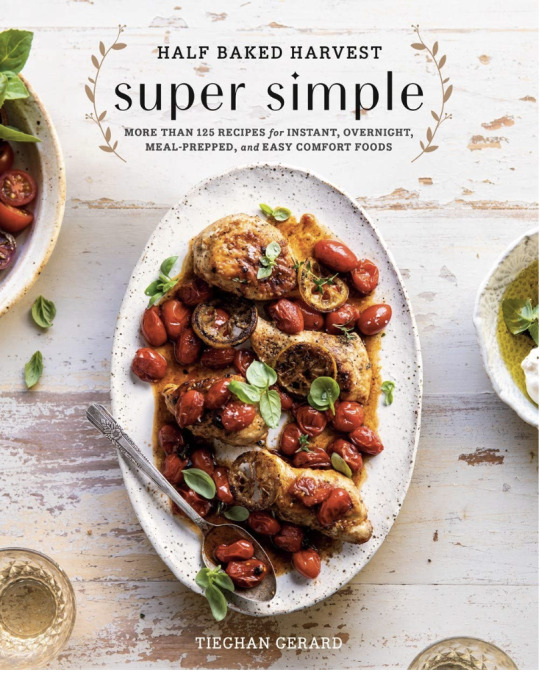
Half-Baked Harvest | Tieghan Gerard
The Basics
Everyday Bread Dough
Everyday Pancake Mix
Everything Bagel Spice
Lemon Basil Pesto
Perfect Pressure Cooker Eggs
No Knead Bread and Pizza Dough
Breakfast & Brunch
Baked Cinnamon Butter Brioche French Toast w Any Fruit Jam
Frico and Polenta Fried Eggs
Buttery Croissant Strata w Spinach and Prosciutto
Egg-in-a-Hole w Tomato and Bacon
Avocado Breakfast Tacos w Crispy Shallots & Chipotle Salsa
Pumpkin Butter Crème Fraîche Pancakes w Whipped Maple Butter
Dad’s Cheesy Eggs
Blueberry Lemon Pull-Apart Bread
Maple-Glazed Cardamom Apple Fritters
Coconut-Banana Muffins
Overnight Cinnamon Roll Bread w Chai Frosting
Appetizers & Sides
Cheesy Poblano & Bacon Quesadilla |Pickled Jalapeño Pineapple Salsa
Ricotta Toast w Honey-Roasted Grapes
Three-Ingredient Blue Cheese Bites
Burrata w Pepperonata and Tomatoes
Herb-and-Garlic Pull-Apart Rolls
Oven-Baked Cajun Fries | Homemade Creole Seasoning
Balsamic Peach and Brie Tart
The Best Pressure Cooker Mashed Potatoes
Cacio e Pepe Brussels Sprouts
Prosciutto-Wrapped Zucchini Bites w Goat Cheese and Thyme
Extra-Smooth Hummus
Maple-Cinnamon Acorn Squash
A Cocktail for Every Season
Pomegranate-Thyme Vodka Spritz
Spicy Strawberry Paloma
Peach Rosé Sangria
Honeycrisp Apple Bourbon Smash
Salad and Soup
Sun-Dried Tomato and Avocado Salad w Chicken
Everything Bagel Salad
Marinated Heirloom Tomato and Nectarine Salad w Garden Herbs
Autumn Harvest Salad
Gingered Thai Steak and Pepper Salad
French Onion Sou[
Creamy Chicken Gnocchi Soup
Broccoli Cheddar Soup
Golden Butternut Squash Soup w Crispy Sage
Salsa Verde and Brown Rice Chicken Tortilla Soup
Butter-Roasted Tomato Soup
Crispy Chicken Khao Soi Noodle Soup
Pizza and Pasta
The Meanest, Greenest Pizza
Sweet and Spicy Pineapple Pizza
Garden Basil Pepperoni Pizza
Harvest Butternut Squash and Apple Pizza
Potato and Burrata Pizza
Three Cheese and Nectarine White Pizza
Spinach and Three-Cheese Stuffed Shells
One-Pot Creamed Corn Bucatini
Spinach and Artichoke Mac-and-Cheese Bake
Penne Alla Vodka Two Ways | Traditional and Pasta Bake
Lemon Basil Pasta w Balsamic Brussels Sprouts
Grown-Up Tomato-Parmesan Pasta
Pumpkin and Sage Lasagna w Fontina
Vegetarian
Black Pepper Buffalo Cauliflower Bites
Hot and Spicy Pot Stickers
Spaghetti Squash Alfredo
Spicy Poblano Tacos w Fried Sesame Halloumi
15-Minute Garlic-Butter Ramen
Mushroom “Cheese Steaks”
Falafel Bowl w Avocado and Lemon Tahini
Moroccan Chickpea and Carrot Tagine
Veggie-Loaded Pad See Ew
Curried Thai Spring Roll Lettuce Wraps | Peanut Sauce
Spicy Potato Shakshuka
Caesar Broccoli w Eggy Fried Toast
Saucy Coconut and Chickpea Curry
One-Pot Herby Buttered Mushrooms and Wild Rice
Poultry and Pork
Walnut-Crusted Chicken w Honey and Brie
Red’s Favorite Schnitzel
Instant Chicken Gumbo
Browned Sage-Butter Chicken Pot Pie
Breaded Lemon Chicken w Burst Cherry Tomatoes
Gingered Apple Pork Chops
Paprika Rubbed “Rotisserie” Chicken
Rosemary Peach Bruschetta Chicken
Chicken Tinga Tacos
Coconut Chicken Tikka Masala
Sage Chicken w Creamy Potatoes
Caroline’s Family’s Chicken Mostaccioli
White Wine-Braised Chicken w Artichokes and Orzo
Kai’s Favorite Sesame Orange Chicken
Quick Filipino Adobo | Coconut Rice
Sun-Dried Tomato Turkey Meatball Bake
Beef and Lamb
Carne Asada Tostadas
Poblano Chili
Spiced Lamb Hummus
Sheet Pan Cuban Steak
Beef Bourguignon
Pomegranate-Braised Short Ribs w Sweet Potato Mash
Thai Basil Beef w Peanut Salsa
Korean Beef w Yum Yum Sauce
Dry-Rubbed Grilled Steak w Garlic-Butter Corn Salad
Baked Coconut-Curry Meatballs
Seafood and Fish
Lemony Halibut and Chickpeas w Farro
Jalapeño Garlic-Butter Shrimp
Parchment-Baked Greek Salmon and Zucchini w Salty Feta
Lobster Tacos w Charred Poblano Cream
Extra-Saucy Coconut Fish Curry w Pomegranate
Slow-Roasted Moroccan Salmon
Browned-Butter Scallops
Jerk Shrimp and Mango Salsa Rice Bowls | The Best Jerk Seasoning
Clams on Toast in Herbed White Wine
Herby Lobster Tagliatelle
Lemon Butter Cod w Orzo and Asparagus
Sesame-Crusted Salmon w Honey-Soy Dressing
Mediterranean Tuna and Focaccia Sandwich
One-Pot Spanish Chorizo, Shrimp, and Rice Pilaf
Dessert
Strawberry Naked Cake
Blackout Chocolate Cake
Coconut Carrot Cake
Easiest Cinnamon-Apple Tarts
Bourbon Peach Pandowdy
Strawberry Pretzel Tart w Whipped Mascarpone
Slice & Bake Snicker-Doodles w Eggnog Frosting
Butter Pecan Bars w Chocolate and Coconut
Chocolate Mousse
Swirled Banana Cake
Chocolate Peanut Blonde Brownie Bars
Chewy Browned-Butter Chocolate Chip Cookies
Fudgy Ice Cream Pretzel Cake
Blackberry Lavender Buckle
Five-Ingredient Hazelnut Brownies
1 note
·
View note
Text
A big neural net reviews a smaller neural net's recipes
I’ve used various neural networks to generate recipes, to varying degrees of success. My earliest recipes were generated with char-rnn, which had to learn everything - spelling, punctuation, words - entirely from scratch. Its recipes were terrible (Swamp Peef and Cheese, anyone? Or Chocolate Chicken Chicken Cake?). Later when I started using GPT-2, I was using a neural net that had already seen a lot of recipes online during internet pre-training, and its recipes looked a lot more realistic (although not entirely realistic - there was that recipe for Black Forest Cake that suggested pouring the batter into a toaster, or the jello recipe that starts with “remove all internal rinds”).
GPT-3, an even more powerful text-generating neural net, has seen so many recipes during its internet pre-training that its recipes are boringly plausible. Bake its Black Forest Cake recipe and you’d probably actually get cake at the end, even if it’s not the best cake in the world. Its recipes aren’t funny at a glance, which is why I haven’t posted any of them - until internet linguist Gretchen McCulloch suggested that, rather than have GPT-3 generate its own recipes, I have it rate char-rnn’s recipes. Readers, it worked.
I prompted GPT-3 with two example recipes from allrecipes, each followed by 3 of their human-written reviews. Then, for the third recipe I inserted one of char-rnn’s recipes:
Chocolate Chocolate Cake
1 cup sugar 1/4 cup butter 1 cup margarine 1 cup cocoa 1 teaspoon vanilla 1 cup margarine 1/2 cup pecans, chopped 1 teaspoon vanilla 1 egg yolk 1/2 cup sugar 1/4 cup chopped pecans 1 cup sugar 1 teaspoon vanilla 1 cup cocoa 1 teaspoon vanilla
Combine flour, sugar, baking powder, salt, salt, and salt in a large bowl. Cook over medium heat, stirring constantly, until mixture boils and stiff peaks form. Add milk and cook until mixture is completely melted. Remove from heat and stir in sugar and sugar. Add eggs and vanilla. Beat until smooth. Spread in batter. Sprinkle with pecans.
Yield: 1 servings
And then I let GPT-3 add reviews. Would it mention the excessive lakes of vanilla? The complete lack of flour? The foolhardy reliance on the heroic efforts of a single egg yolk to hold things together?
oxtailsandturnovers Rating: 5 stars 03/04/2007 delicious chocolate recipe!!! and the perfect balance between cocoa and chocolate. and they sure were LONGNECKS! big time rave here. lazy w birthdays w friends and family, try this recipe for something chocolate sweet the ppl will talk about over and over.
AKEMIYUNA Rating: 5 stars appraisal 12/03/2008 Excellent for the kids Halloween party. Everyone got so thrilled by seeing something new on Chocolate in sponge. He even likes nuts separately but it will taste good..
BYOMFYABF Rating: 2 stars 10/01/2008 I could only give it a 2 as I had to make changes to it due to ingredients I had. First, I used Dove Dark Chocolate cocoa instead of Hershey's, no nuts, and the mashed bananas and caramel topping were a must. I did use coffee instead of the hot water, and dark margarine instead of regular, therefore I could not use light whipped cream, but I made homemade whipped cream. It had WAY too much flour in it, but i guess it could have been me measuring heavier than I should have. I also only used 2 cups of flour. it was my first bundt cake, so it was huge!!!
Here’s another batch of reviews, this time of a more chaotic char-rnn recipe:
Simple Soup Alaborate Soup Pie
6 each chopped white perserves; ** (optional but ring) 1/2 cup chopped fresh marjoram 1/2 teaspoon dried thyme 1/3 teaspoon salt 1/2 cup thinly sliced onion 1/4 cup onion (chopped) 1/2 teaspoon garlic; minced 2 small carrots 6 can dry white wine 1 tabasco sauce 1 tablespoon sugar 1/2 cup flour, whipped topping 2 tablespoon chili powder
Marinate: Serves 4. Whip and short under boiling. Add the sliced mushrooms and peppers and stir to coat. Stir the sugar and carrots. In large bowl, beat the egg to make a 1 1/2 tablespoons of the flour. Add shanks and stir it well. Spoon into a frying pan before serving.
Recipe By : DonajehLi Koubmanda
Yield: 8 servings
JEFFREY97389 Rating: 2 stars 03/03/2006 Even though everyone said this was great, I thought it was just 'OK!' The perserves gave a strange flavor to the sauce.
MATTJANDTRACER Rating: 2 stars 01/02/2009 This recipe sounded good. When it came out it tasted a bit like a casserole and not a stew. I used venison instead of deer and pork. I liked the way it turned out, but it wasnt very French.
Hammy Rating: 5 stars The g iving this as a gift as it takes about 10 less minutes but using American cheese and not blended with parsley flakes, lime-flavored gelatin, which is my husband's favorite dish from SuperValu. Just happens to be the creamy sauce. Don't worry about a pie crust.
In fact, the more chaotic the char-rnn recipe, the more chaotic the reviews tend to be, as if GPT-3 has picked up on the chaos and is trying to somehow produce reviews that could plausibly be written by whatever weird humans are visiting this mangled recipe website.
Geilded Peanuts & Crabmeat Basil
3 beef, boneless chops, or thyme, 1 lamber and flince of fresh diced in diagonal 1 parsley 2 large leeks (for garnish) 3/4 teaspoon sesame oil, seeded and peeled 1 any jeans'l-tortilla 1 pepper or cinnamon 1/4 cup baesly pinto beans. (Crushed and thawed; minced fine you recipe) 1 tomato base 1 fat in the last 5 inch plates 1 garlic clove; crushed 1/4 cup dijon mustard
In a large bowl set aside. Remove the sides from the heat and saute with a fork and cover and cook on Low for 6 to 6 hours.
Yield: 6 servings
Morales Rating: 0 stars 03/30/2008 I had high expectations for this recipe, but it was an outright flop. I don't know if the measurements were somehow incorrect or what, but I ended up with a watery mess that certainly wasn't crab salad. My girlfriend, who is a new chef liked it fine, but I really wish that the recipe didn't claim that it made six servings when it really made enough for one, if that's what we were going to call it.
Carole Rating: 5 stars Glorious sobs! This recipe will be delicious for a minumum of 1½ Hours to maximum 2½ hours Time to bring lots of fresh sized potatoes in the house or grow in the age may become quite famous
Amanda Rating: 3 stars 11/13/2009 My friend is having a birthday party and will celebrate with Camping. She's in charge of the dishes and wanted to serve food at the campfire. I'll 10th grade, my easy information for her party. It will not sound strange anyway test this task with a note to work rationally.What to take trees, portable tables for chairs, the main meal, food. I personally love the taste of it but has anyone seen a shepherd (wasn't any spices), oysters. It is sufficient
It does kind of make sense that GPT-3’s recipe reviews aren’t directly complaining about the utter weirdness of char-rnn’s recipes. Probably very few of the recipe reviews in GPT-3’s training data involved baffled complaints about nonexistent or repeated ingredients, or apocalyptic levels of recipe failure. So GPT-3 has learned that even the critical reviews tend to fall within a certain sentiment range. It’s interesting that it tries to emulate char-rnn’s primitive neural net glitchiness - I’ve noticed before that GPT-3 seems to be capable of pretending to be a much simpler neural net.
Subscribers get bonus content: After generating a few reviews, GPT-3 would sometimes go on to generate new recipes (such as “BBQ Cheeseburger Salad” which contains lime jello, whipped topping, and sliced black beans). It may have been deliberately trying to make them terrible to fit in with char-rnn’s recipes.
Speaking of AI-generated recipes: there are some absolute disasters in my book on AI, You Look Like a Thing and I Love You: Amazon - Barnes & Noble - Indiebound - Tattered Cover - Powell’s - Boulder Bookstore
328 notes
·
View notes
Text
Quarantine Cuisine: Soup Making 101
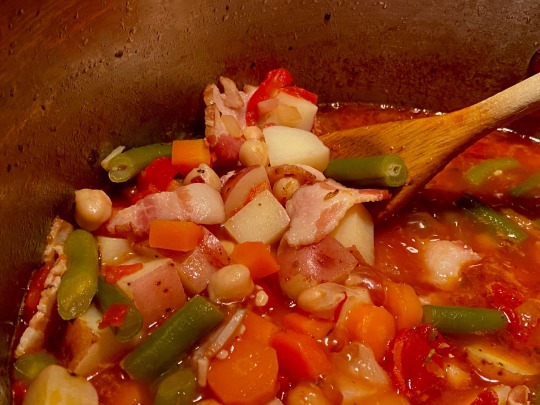
So here’s another installment that’s more technique than recipe (though don’t worry... there is a recipe at the end). Forgive me for going a little long with this one, but I feel like not enough people know how to look at their pantry contents and summon soup. So... here we go. Soup-making 101.
Here are the basic building blocks of soup:
Protein:
If you’re wanting soup that is an actual meal, you’ll need protein, and since it’s sort of the central component of your soup, it informs every decision trickling down. Cook time, flavor palate, additional ingredients. On and on and on... And the list of soup-worthy proteins is endless. In fact, it’s probably best to list what -doesn’t- make good soup. And generally, what doesn’t make good soup is anything that is best cooked on high heat for a short amount of time. So... lean steak, delicate fish... things of that sort. Here are your best choices in most categories...
Meat: anything tough like roasts, shoulders, shanks. And sausage... links or ground. And anything cured like bacon or ham. (watch your salt with those though). You basically want things that aren’t going to just boil away... things with some fat and connective tissue.
Chicken: Thighs. 100%. You can do breasts but it’s a pain because they dry out with long cooking. And they’re more expensive. Just do chicken thighs.
Seafood: shrimp or clams... tougher fish like swordfish. But unlike the proteins above, you don’t want to add them in until the very end.
Veg: any sort of bean or mushroom. Lentils... all that good stuff.
If you’re new to soup making, I recommend starting with something forgiving. Chicken thighs, bacon, ground beef or sausage, mushrooms, or chick peas... These things stand up to being souped and are pretty hard to overcook. That said, your meat choice will arbitrate your cooking time. Meat with lots of connective tissue needs a longer cooking time, whereas chicken thighs will only take about 20-30 minutes to cook through. Keep that in mind moving forward.
Broth:
Your broth choice depends largely on your previous decision... but you can sort of think of it like wine. Red wine is like darker heavier broths like beef... save it for the red meat. Chicken broth is like a dry sturdy white wine... good for chicken obvs but also veggies. Fish broth is really only good if you’re making a fish dish. And veggie broth... I really only ever use it for keeping a dish vegetarian... it’s good but the flavor isn’t super strong. My go-to is chicken broth for most everything except heavy beef stew. And even then it would work in a pinch.
There are other liquids to consider as well. Wine... vinegars... acids... juice... coconut milk... but we don’t want to really settle those until we decide the following.
Fat: All soups need a little fat. It can come from your protein if you’re using meat... or you can go with oil or butter. Keep it fairly neutral.
Aromatics and spices: Herbs, spices, and things like onion, lemongrass, garlic, or ginger. This is where you decide your flavor palate. And don’t worry... it’s not complicated. I tend to choose my flavors based on geographical location. Here... watch.
French soup: onion/shallot, celery, carrots, tarragon, parsley, lemon, thyme, rosemary.
Italian soup: onion, celery, carrots, a shitload of garlic, oregano, basil (fresh or dried).
Thai: onion, ginger, garlic, chili paste, lemongrass, Thai basil
Indian: red onion, garlic, ginger, garam masala, curry powders, turmeric
Central American: lime, garlic, cilantro, onion, cumin
Or if you really want an advanced course in flavor matching, check out this book:
The Flavor Bible by Karen Page and Andrew Dornenburg.
You can search by ingredient and see what goes with it. Magic! It’s probably the most well used cook book on my shelf and it’s not even a cook book!
Veg: Again... go with things that are forgiving when it comes to cooking time: Mushrooms, carrots, celery, bell peppers, sturdy beans, frozen corn. But that being said, you can add things in stages. Simmer your meat and onions and carrots for awhile... add more sensitive things like potatoes in a little later. Then when everything is almost done, toss in your spinach or fresh peas and such like that to just cook through at the end. Carbohydrate: Honestly... pick your poison. Potatoes, rice, barley, pasta... go nuts. Just pay attention to the cooking time and be careful not to overcook.
***
So, with those base ingredient categories in mind, we’re just going to think like we did with the scrappy pasta from last week. You want certain flavor roles filled: Salty, sweet, fat, acid, umami.
Salty: salt. Just... straight up. You don’t always have to have something filling in... but other things to think about that might help in that department are sausage, bacon, soy sauce, grated cheese. And bear in mind... if you’re using a lot of starch like with beans, pasta, or potatoes, keep tasting as you work along to make sure you use enough salt.
Sweet: Okay we’re not talking sugar... but think about things that have a sweet component to them. Carrots, sweet peas, sweet corn... it isn’t a must have but it helps keep a dish from falling too flat.
Fat: This can come from the meat you’re using or be added by you. Keep the smoke point high so things like plain olive oil (not Extra Virgin), bacon fat, or a little butter are best. Save your fancy stuff for something else. This is more utility than anything.
Acid: This will also help keep your soup from just being all one note. Tomatoes make a great acid. As does a splash of red wine vinegar or lemon juice right at the end of cooking.
Umami: Ah that witchy little concept... the X factor of every dish. It’s hard to explain exactly what umami is. It’s a complexity that usually comes from a combination of flavors... think about chocolate and pretzels, and the way those two ingredients bring out flavors that don’t exist when those two things are eaten on their own. Have a look at this list and you’ll know what you’re looking for... bacon, toasted sesame oil, olives, parmesan cheese, miso paste, balsamic vinegar. For savory dishes, it’s usually something aged, brined, or smoked. You get the picture.
Alright... all that out of the way. I’m going to make an example soup from just crap in my pantry. I’ll give substitutions as we go along as well. Another thing you can do is google soup recipes and use this guide to make substitutions. It’s like you’re one of those neural net learning computers! Only with better context clues.
***
Pantry soup:
6 pieces of bacon, cut into one inch pieces (could also be literally any kind of fatty meat... sausage, ground critter. I wanted this to be a mostly veggie soup, so I’m going with this one)
one onion, chopped (could also be some shallots)
four carrots, cubed (could also use some celery here if you have it. I don’t.)
3-4 cloves of garlic
Some white wine... 1/2 cup-ish (for my acid and for liquid... you could totally just use more broth, but a note about cooking with alcohol... there are flavors that are soluble in alcohol but not in water. Use both broth and wine... you get the best of both worlds.)
Chicken broth (enough to liberally cover all the ingredients... this took about 48oz)
one Parmesan rind (or a little Parmesan cheese)
1 14oz can diced tomatoes, juice and all. (Pro tip... rinse the can out with about half a cup of water and dump that into the pot too so you get all the flavor.)
1 bay leaf
1 tsp Italian herbs
1/4 tsp red pepper flakes
salt and pepper
1 14oz can chick peas drained
one cup frozen green beans
3-4 potatoes cut small
spritz of lemon juice.
Things I don’t have but really wish I could add to this: Mushrooms, celery, bell peppers, and fresh spinach. Other possible adds could be frozen corn, frozen peas, sweet potatoes, kale, fresh grape tomatoes (halved), other beans like kidney, cannellini, or great northerns. In a large, heavy bottomed pot or dutch oven, cook bacon until it starts to get some color and most of the fat is rendered. Scoop the bacon out with a slotted spoon. Add onion and carrots and saute until softened. Add garlic and cook for a minute more.
Add white wine and scrape up any bits stuck to the bottom of the pan and allow to cook down by half. Add the broth, bacon, tomatoes, Parmesan rind, and spices. Bring to a simmer and cook for about 20 minutes. Taste for salt here. I’d go easy up to now, what with the bacon and the parm. But with the potatoes and the chickpeas coming into the mix, you’re going to want to make sure the broth is well seasoned. Scoop out the Parmesan rind. Add the chick peas, green beans, and potatoes and cook for an additional 30 minutes, or until potatoes and carrots are fork tender (it was closer to 40 minutes for me). Taste again for salt.
Spritz with lemon juice and serve.
27 notes
·
View notes
Text
If you don’t like onions, this is not for you
Spoiler alert: this also contains meat so this is definitely not for all you vegetarians or vegans out there. (Sorry, not sorry)
But if you love Italian food, specifically tube shaped pasta, onions and meat, you’ll absolutely adore this dish. I’m talking about a sauce that has a lot of onions and braised meat, cooked for hours, eventually melting away to form this sweet, meaty, gooey sauce that’s paired perfectly with al dente pasta, garnished with fresh herbs and as much grated parmesan as you like.
The dish I’m talking about is Tortiglioni all Genovese, a pasta sauce from the region of Campania in Italy. According to some very half-assed internet research (Wikipedia), it was introduced to Naples from Genoa during the Renaissance. And since then, it has become very famous in the region but forgotten elsewhere mysteriously.
I came across this gorgeous dish when in Naples, at a restaurant that specialises in ragu called Tandem. Of the many delicious and numerous pasta dishes we ordered that evening, when this dish hit the table and went into my face, I was immediately jealous that it was Kei who made the order (she’s always had the better judgement when it came to menu items) and proceeded to eat most of it.
The dish was luscious and velvety, where you could taste the sweetness of the onions, married with a subtle hint of the sea (they used octopus instead of beef). That experience has lingered with me ever since.
And so in this time of social isolation, coupled with the fact that I’m stuck at home after an ACL reconstructive surgery on my left knee, meant that this was the perfect opportunity to try to recreate this Neapolitan classic. However, if you google “Pasta alla Genovese”, it’s all becomes very confusing because all you seem to get from Google are recipes for a pesto-based pasta with fine beans, which is not what this is all about.
Amidst the confusion and hysteria, I turned to New York Times Cooking, where they had a delightfully clear and simple version of the recipe by Mark Bittman, food author.
Sidenote: Mark (yes, we’re on a first name basis) has written a bunch of great cookbooks like the incredible “How to Cook Everything: 2,000 Simple Recipes for Great Food” which is one of the better books if you’re looking to start cooking. As a warning, it is a mammoth of a text as it literally has 2,000 recipes so have a sturdy bookshelf before ordering.
So after endless onion prep, cramp from standing on my one good leg and a cook that lasted over three hours, I instinctively knew that this recipe was going to be near and dear to me before it was even completed. And the final result was everything I had hoped for and sent me to carb heaven.
Like my experience in Naples, what stood out to me the most was the amount of flavour and joy packed into every bite. You could taste the natural sweetness of the onions and the slight “oomph” from the chuck steak, enhanced and tempered with only time and heat.
Ultimately, this is an incredible expression of what I believe good food should be, simple ingredients cooked with patience and love. I hope you try the recipe and love it as much as I do. Enjoy.
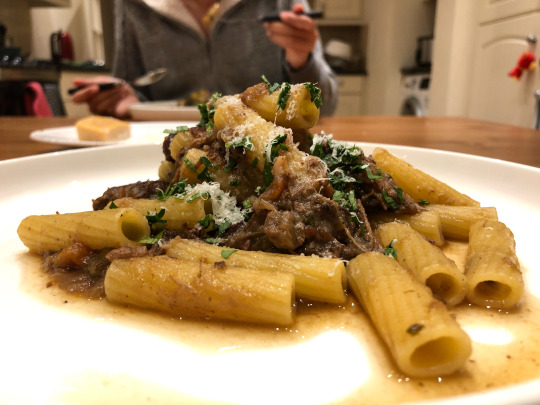
Tortiglioni alla Genovese
Servings: 6 to 8 (or 3 to 4 if you’re me) Cooking time: 3 1/2 hours (strap in and open some wine)
Ingredients
2kg red onions, thinly sliced (wear your goggles or prepare to cry for awhile)
Extra-virgin olive oil (use that good shit)
2 carrots, peeled and roughly chopped
2 celery ribs, trimmed and roughly chopped
120g pancetta, chopped (I used 180g because that was the package it came in and I didn’t want to keep a random 60g of pancetta lying around, plus animal fat = flavour)
1kg beef chuck, cut into 2-inch cubes (or any alternative cheaper, leaner cuts used for braises or stews)
Salt and freshly ground black pepper
2 bay leaves (I used four because I got mine from Chinatown that comes in a giant packet for cheap. Therefore I worry that the quality of the leaves aren’t as good as the ones you would get from a farmers market or fancy supermarket so I overcompensated)
Handful of oregano leaves (or you can tie a bunch of oregano together and fish out the stems later on. I like leaving the leaves in and I’m lazy to pick stems out)
Some dry white wine (to taste and drink while you cook)
500g dried pasta, like ziti, tortiglioni or rigatoni
Finely grated Parmesan cheese
Fresh parsley, finely chopped
Preparation
Use a large heavy pot over medium high-heat, season your beef chuck cubes and coat them with oil. When pot is hot, starting putting the beef cubes into the pot to brown the meat on all sides. Be sure not to crowd your pot or else it won’t brown properly. You may have to do this in batches but once done, set browned meat aside. Additional note: You may skip this step if you want as browning the meat is slightly unnecessary. I only did it because I wanted the beef to hold its shape for a bit more bite at the end. In fact, according to more half-assed internet research (i.e., one other internet link), most classic Italian recipes will call for a large cut of beef chuck steak, which would be set aside once cooked and served as a second dish. This is how I did it but it’s your kitchen, your choices.
Heat a healthy glug of extra virgin olive oil in the same pot over medium-high heat again; chuck in the carrots, celery and pancetta and cook until it’s browning or caramelised (DON’T FORGET TO SEASON AND ADD PEPPER AS YOU GO, TO TASTE)
Add your onions to the pot, seasoning again as the salt will draw out the water in the onions quicker, you may even add a splash of water at this point if you’re worried that the bottom will burn because you’ve never seen so much onion go into a single pot before unless you’re cooking a giant batch of French Onion soup.
When it looks safe and it doesn’t look like your bottom is burning, chuck in the browned beef cubes. (Pun fully intended)
Add in your bay leaves and oregano and give your pot a little stir.
Bring it all to a simmer, cover it and cook it low and slow for two hours (or more), you will be amazed at the amount of water that will come out of the onions. It will almost be as much as the tears you shed while prepping 2kgs of onions by hand.
Once the meat is squishy and tender, uncover and crank up the hit all the way to bring it to a boil. This is wear you will need to be a bit more active with the stirring, making sure nothing sticks and burns at the bottom. Fiddle around with your heat if you need to. Cook until the meat falls apart or you can stab at the pieces of meat as you’re stirring to help it along a bit. This will be roughly 45 minutes of stirring so you best be ready.
Once the meat is falling apart and the sauce is thick, gooey and beautiful, add half a glass of wine to it and bring your heat down to low. If you’re a drink while you cook type human, you should have just enough white wine left from when you first opened a bottle at the start of this cook. Or perhaps you need to open your second bottle. No judgements here, just solutions.
Stir until the sauce is glossy. When you can’t taste the alcohol in the sauce anymore, it’s good to go. Although if you’re on your second bottle, best get someone to taste just to be sure.
Cook your pasta in a large pot of boiling salted water. I won’t go into detail here because I’ve covered how I cook pasta in this recipe here. (Don’t @ me)
Garnish with parsley and parmesan.
Eat all of the pasta.
Food coma.
#recipe#food#pasta#genovese#napolitan#naples#tandem#foodporn#homecooking#nytcooking#carbs#carbsarelife#omnomnomnivore#noms#ragu#coronavirus#quarantinelife
2 notes
·
View notes
Text
French Food and Wine Pairings
French Food and Wine Pairings
France has one of the broadest cuisines on earth. Its influence on western food is undeniable. It has been the inspiration and starting point of many food trends and styles for generations. Classic French cuisine, as interpreted by talented chefs like Escoffier and Bocuse, will never go out of fashion.
Distinct regions divide France, each with deeply rooted cooking traditions that revolve around one cornerstone of French culinary tradition: wine.
Whether we’re talking about the alpine highlands, the Atlantic shores, or the warm Mediterranean basin, food is always remarkable, and pairs heavenly with local wine.
These are some of the most representative French wine and food pairings. True classics to know and love.
Muscadet and Oysters
Strong, humid winds hit the Atlantic coast of North-eastern France; home to one of the most underrated classic wine styles: Muscadet. The neutral, acidic, simple-is-beautiful wine pairs well with the oceanic produce of the region.
Crustaceans, herring, scallops and sole are typical of the area. They all work well with the citric, mouthwatering whites like Muscadet. Tourists and locals classically enjoy oysters, raw on their shell, always with a glass of the cool white made with the Melon de Bourgogne grape.
Sauvignon Blanc and Soft Cheese
Follow the Loire river into continental France to find vast extensions of Sauvignon Blanc vineyards; the weather is cold enough to produce wines with piercing acidity and enticing sharp flavors.
These wines are perfect for the goat cheeses made in the region like Valençay and Chavignol. Craftsmen also produce Brie and Camembert close by, styles that work nicely with the aromatic Sauvignon too.
The French make goat’s cheese all around the country, this is the original chèvre. Shaped as a crottin, pyramid, or cylinder, either powdery white or covered in ash, styles are limitless. Harder and weightier examples of goat cheese exist, but it’s the fresh, soft examples that shine best with Sauvignon Blanc.
Alsace and Choucroute
Alsace is a magical region dosed with a German spirit. You can see it in the architecture, and also in the food. Pork sausages, ham, it all mirrors the typical Germanic table.
Their famous mixed platter of charcuterie with sauerkraut called choucroute garnie is a great example of the region’s culinary tradition.
Alsatian white wine, whether it’s Riesling, Pinot Blanc, Gewurztraminer or Muscat, goes well with the uncomplicated Alsatian dishes.
A pizza-like dish called tarte flambé, baked flatbread topped with cheese and onion, or the ubiquitous quiche are other classic examples of white food that works great with white wine. Alsatians make excellent beer too, another classic pairing to discuss another time.
Burgundy and Boeuf Bourguignon
Hundreds of years of political, religious and merchant activity have made from the quiet hills of Burgundy a gourmand’s utopia. From escargot to coq au vin, the province has plenty of inspiriting dishes to offer alongside their world-famous wine.
Boeuf bourguignon is a classic beef stew. This one-pot dish might seem like peasant food, but it’s a regal example of the typical French food. Carrots, onions and local herbs give flavor to this dish, but the secret ingredient is wine, from which the recipe gets its second name.
A good example of Burgundian red, especially sturdier Pommard or Gevrey-Chambertin have the weight, acidity, and matching flavors to tame the substantial dish.
Bordeaux and Canard
Red Bordeaux is almost always a merger of several local grapes, Cabernet Sauvignon and Merlot leading the way. The structured wine is a well-known match with beef and lamb, but locals love pairing it with another local speciality: duck.
Confit de Canard consists of flavorful duck meat cooked in its fat. The result is an intense dish matched only by the tannic grip, and generous bouquet of the red Bordeaux wines. Acidity is vital to cut the fatty meat too. The result is a heavenly pairing like no other.
Beaujolais and Andouillette
Beaujolais is both a wine region and a wine style. The young, lively Beaujolais Nouveau is surely the first thing to pop up on your mind, but dedicated producers make age-worthy examples in the best sites, all from the misunderstood Gamay grape.
Lyon is the gateway to the Mediterranean basin, still influenced by the intellectual Burgundian cuisine, this city has a rich culinary history. The Andouillette sausage, a regional favorite, is made of pork and veal offal.
This delicacy is strongly flavored, especially when grilled. It has a wild profile that goes very well with the light-bodied red Beaujolais. The uncomplicated wine plays a secondary role, but a crucial one reviving the palate and boosting a whole array of ripe fruit aromas to the pairing.
Provence Rosé and Bouillabaisse
There’s no better seafood stew than the Provençal Bouillabaisse. Fresh, local ingredients and Mediterranean seasoning makes this flavorful soup an ideal dish to pair with warm sunny days. Ask anybody, and you’ll see that the dry, precise rosé from the region is not just the right way to go, but the only one.
French rosé has crisp acidity and addictive subtle red fruit flavors that work well with any Mediterranean dish and sea produce. Sipping rosé in the Côte d’Azur should be on everyone’s bucket list, and enjoying a warm Bouillabaisse while at it, simply makes it better.
The list goes on and on; French cuisine was born alongside winemaking tradition. Local pairings have been fine-tuned by time, and recipes transcend generations. The result: Gastronomic heaven.
The post French Food and Wine Pairings appeared first on SOMM • Reviews of Sommelier Courses and Wine Schools.
from SOMM • Reviews of Sommelier Courses and Wine Schools https://www.somm.us/french-food-and-wine-pairings/ from SOMM https://somm3.tumblr.com/post/188632934614
1 note
·
View note
Text
French Food and Wine Pairings
French Food and Wine Pairings
France has one of the broadest cuisines on earth. Its influence on western food is undeniable. It has been the inspiration and starting point of many food trends and styles for generations. Classic French cuisine, as interpreted by talented chefs like Escoffier and Bocuse, will never go out of fashion.
Distinct regions divide France, each with deeply rooted cooking traditions that revolve around one cornerstone of French culinary tradition: wine.
Whether we’re talking about the alpine highlands, the Atlantic shores, or the warm Mediterranean basin, food is always remarkable, and pairs heavenly with local wine.
These are some of the most representative French wine and food pairings. True classics to know and love.
Muscadet and Oysters
Strong, humid winds hit the Atlantic coast of North-eastern France; home to one of the most underrated classic wine styles: Muscadet. The neutral, acidic, simple-is-beautiful wine pairs well with the oceanic produce of the region.
Crustaceans, herring, scallops and sole are typical of the area. They all work well with the citric, mouthwatering whites like Muscadet. Tourists and locals classically enjoy oysters, raw on their shell, always with a glass of the cool white made with the Melon de Bourgogne grape.
Sauvignon Blanc and Soft Cheese
Follow the Loire river into continental France to find vast extensions of Sauvignon Blanc vineyards; the weather is cold enough to produce wines with piercing acidity and enticing sharp flavors.
These wines are perfect for the goat cheeses made in the region like Valençay and Chavignol. Craftsmen also produce Brie and Camembert close by, styles that work nicely with the aromatic Sauvignon too.
The French make goat’s cheese all around the country, this is the original chèvre. Shaped as a crottin, pyramid, or cylinder, either powdery white or covered in ash, styles are limitless. Harder and weightier examples of goat cheese exist, but it’s the fresh, soft examples that shine best with Sauvignon Blanc.
Alsace and Choucroute
Alsace is a magical region dosed with a German spirit. You can see it in the architecture, and also in the food. Pork sausages, ham, it all mirrors the typical Germanic table.
Their famous mixed platter of charcuterie with sauerkraut called choucroute garnie is a great example of the region’s culinary tradition.
Alsatian white wine, whether it’s Riesling, Pinot Blanc, Gewurztraminer or Muscat, goes well with the uncomplicated Alsatian dishes.
A pizza-like dish called tarte flambé, baked flatbread topped with cheese and onion, or the ubiquitous quiche are other classic examples of white food that works great with white wine. Alsatians make excellent beer too, another classic pairing to discuss another time.
Burgundy and Boeuf Bourguignon
Hundreds of years of political, religious and merchant activity have made from the quiet hills of Burgundy a gourmand’s utopia. From escargot to coq au vin, the province has plenty of inspiriting dishes to offer alongside their world-famous wine.
Boeuf bourguignon is a classic beef stew. This one-pot dish might seem like peasant food, but it’s a regal example of the typical French food. Carrots, onions and local herbs give flavor to this dish, but the secret ingredient is wine, from which the recipe gets its second name.
A good example of Burgundian red, especially sturdier Pommard or Gevrey-Chambertin have the weight, acidity, and matching flavors to tame the substantial dish.
Bordeaux and Canard
Red Bordeaux is almost always a merger of several local grapes, Cabernet Sauvignon and Merlot leading the way. The structured wine is a well-known match with beef and lamb, but locals love pairing it with another local speciality: duck.
Confit de Canard consists of flavorful duck meat cooked in its fat. The result is an intense dish matched only by the tannic grip, and generous bouquet of the red Bordeaux wines. Acidity is vital to cut the fatty meat too. The result is a heavenly pairing like no other.
Beaujolais and Andouillette
Beaujolais is both a wine region and a wine style. The young, lively Beaujolais Nouveau is surely the first thing to pop up on your mind, but dedicated producers make age-worthy examples in the best sites, all from the misunderstood Gamay grape.
Lyon is the gateway to the Mediterranean basin, still influenced by the intellectual Burgundian cuisine, this city has a rich culinary history. The Andouillette sausage, a regional favorite, is made of pork and veal offal.
This delicacy is strongly flavored, especially when grilled. It has a wild profile that goes very well with the light-bodied red Beaujolais. The uncomplicated wine plays a secondary role, but a crucial one reviving the palate and boosting a whole array of ripe fruit aromas to the pairing.
Provence Rosé and Bouillabaisse
There’s no better seafood stew than the Provençal Bouillabaisse. Fresh, local ingredients and Mediterranean seasoning makes this flavorful soup an ideal dish to pair with warm sunny days. Ask anybody, and you’ll see that the dry, precise rosé from the region is not just the right way to go, but the only one.
French rosé has crisp acidity and addictive subtle red fruit flavors that work well with any Mediterranean dish and sea produce. Sipping rosé in the Côte d’Azur should be on everyone’s bucket list, and enjoying a warm Bouillabaisse while at it, simply makes it better.
The list goes on and on; French cuisine was born alongside winemaking tradition. Local pairings have been fine-tuned by time, and recipes transcend generations. The result: Gastronomic heaven.
The post French Food and Wine Pairings appeared first on SOMM • Reviews of Sommelier Courses and Wine Schools.
Source: https://www.somm.us/french-food-and-wine-pairings/
from SOMM https://somm3.wordpress.com/2019/10/27/french-food-and-wine-pairings/
1 note
·
View note
Text
Sunday, 14th July 2019 – The Yeatman, Vila Nova de Gaia
Sunday night was the blow out meal of the weekend, a 2 Michelin-starred tasting menu in what might be the best hotel in the area, the Yeatman. First, however, we stopped off for a drink in Porto before getting a taxi across to Vila Nova de Gaia. In our search for a good place to get a drink, we stumbled upon the Livraria da Baixa, another of the ex-bookshops that have become other things over the years. There seems to be quite a bit of that going on in Porto. We had yet another porto tonico, and this one was different again. The barman asked us which one we liked best, but they were all good in their own ways.

After we’d finished our drinks we headed to the Intercontinental and asked the concierge to find us a taxi to the Yeatman. It didn’t appear, after all, to be the sort of place we wanted to fetch up in looking all sweaty and dishevelled! Also, we wanted to get there a little early so we could have a second round of drinks in Dick’s Bar up there. We’d heard it had excellent views. The taxi pulled up and several uniformed doormen appeared to hold doors open and point the way for us.

It’s very nice! We were escorted in, shown to the restaurant, and asked if we could start the evening in the bar. We were soon installed in a table on the terrace overlooking the river and it is certainly reasonable to say they have a view. As well as the river, and Porto opposite, you get a view of the gardens and the swimming pool – the latter appeared to be full of seagulls using it as a giant birdbath. Perhaps they have a better class of seagull at the Yeatman. Who knows!

Armed with a port cocktail each we dragged our attention away from the seagulls, and towards the view. The weather was not as clear as we might have liked, but the vista is still pretty impressive, even without sunshine and blue skies. I rather imagine in fine weather it would be gorgeous.

The port cocktails were pretty good too!

We decided it was best not to have a second round, and instead moved across to the restaurant to start dinner. There is only the tasting menu (at €170 per person), but if, as we did, you reserve online, this is emailed to you along with your confirmation so you can let the restaurant know if there is anything you don’t eat. In our case it was the pork option, so we let them know and then relaxed into the evening, knowing we’d be well looked after. I should also say that the restaurant has great views, but we weren’t on a window table (I assume those probably go to people actually staying at the hotel), so I only got a photo at the end of the evening.

The first thing that happened, given the Yeatman is part of the Taylor’s port group, was that we were offered a glass of white port as an aperitif while we looked at the menu to make sure it was still to our liking, and we checked the wine list and decided on that or the matching wines chosen by the restaurant for an extra €75 for 6 different wines). The wines in question can also all be bought through the Yeatman Wine Club so it was really easy to establish what we’d had for once. The aperitif was a glass of Churchill’s Dry White which is rather more sweet than the name implies, though it still has a good, dry finish and peppery notes that would probably mean it’s good with cheese too. It worked very well in the heat, well chilled as it was, even if taking a good sniff of it left condensation all over the glass!

Before the first course of the tasting menu arrived, our first glass of wine was delivered, a Filipa Pato 3b Rosé (https://www.theyeatmanwineclub.com/en/espumante-filipa-pato-rose-3b) or more precisely perhaps Filipa Pato & William Wouter 3B Metodo Traditional Rosé, Bairrada, Beiras, Portugal, fresh, elegant, sparkling and just the thing with the parade of amuse bouches that arrived next.

First up, however, was a pair of cool towels for us to freshen up with, which were much welcomed.

The first morsels of food started to appear! And they were good! The first items was described as a Cocktail of apple, spinach and kale (manzana, espinacas y col) and was served with a very fresh bowl of oyster, jalapeños and apples with was fresh from the apples, tasted of the sea and packed a lively punch from the jalapeños.
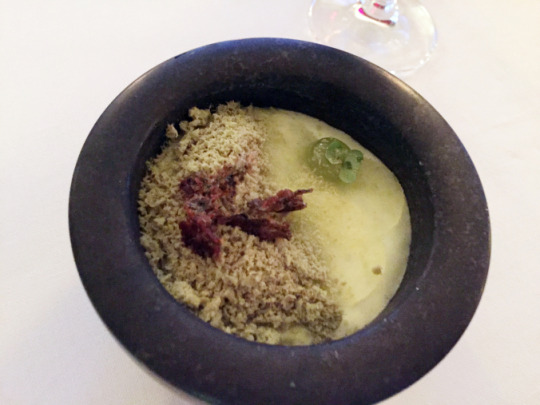
It was soon joined by a tiny selection of “fish and chips” with two tangles of thinly chipped potato, and a piece of batters fish each. It was both fun and fabulous, and it was quite clear that the kitchen and the chef know what they are doing and have a sense of humour.

The cocktail was delicious (and may be the only way to deal with kale in a way that makes it palatable rather than like trying to eat crispy cardboard)! It was also a slightly alarming shade of green, with sweetness from the apple overlaying a slight cabbage-y bitterness.
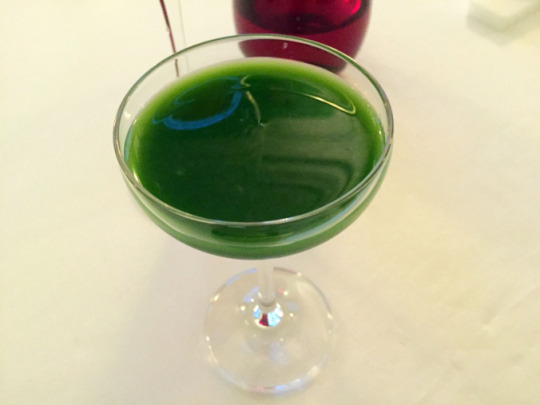
The next round was barbeque chicken, and again demonstrated both humour and skill with a chicken sandwich, a smoked chicken oyster in panko breadcrumbs, and a chicken liver mousse, and superb even to those of us who normally avoid chicken (mostly for fear of how it might have been raised, though I rather suspect that the Yeatman is as concerned about provenance as Lynne and I are).

The final round of amuse bouches was tuna-based with a bonito “nitrogeno” that was tartare-style…
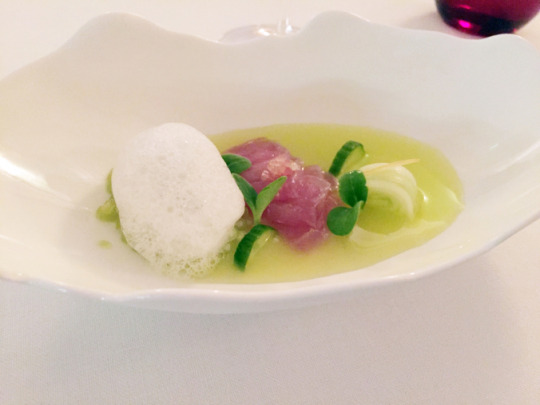
And a tuna “sandwich”, with fish roe and mayonnaise wrapped in a nori seaweed sheet. It was a fun thing, full of flavour and it came with its own little dramatic reveal from inside a scroll of paper that the waiter then opened at the table. I was liking this place, because although there is a formality to the Yeatman, there is also a great deal of playfulness, and the staff could not be friendlier.
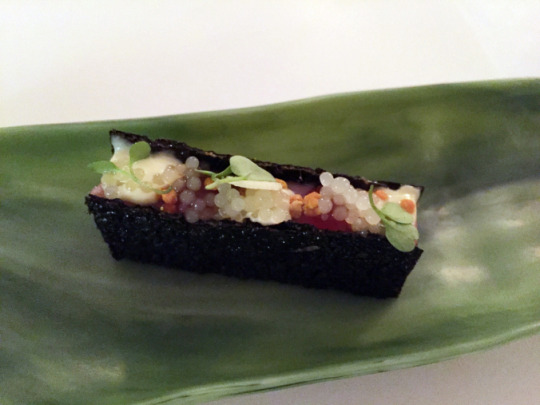
The sommelier brought the next wine, an Ilha do Pico Arinto 2017, from the Azores and fermented in oak vats for 6 months. The result is incredibly drinkable, especially with seafood, which is where the menu started. It doesn’t look as if it often escapes from the Portuguese speaking world, which is a pity because I really enjoyed it and would like to drink more of it.

It went brilliants with the Gamba Blanca (crayfish) with crab and clams. The crab and clams were in the form of a neat little beignet, and we were encouraged to use our hands to eat it rather than being wussy and using cutlery, neat though the cutlery was.
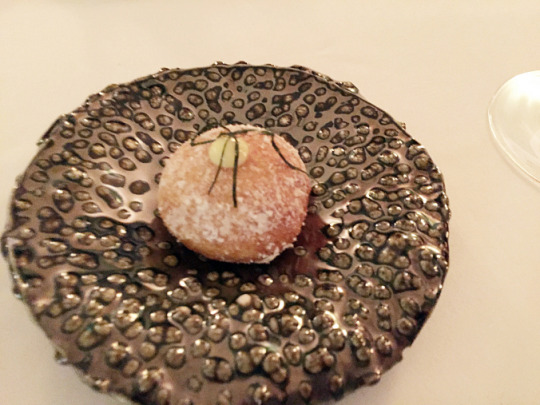
There was a sauce with it that needed to be scooped up and smeared on the beignet, and it was a positive pleasure to do just that. The dish was described as including chawanmushi, a traditional Japanese appetiser of steamed savoury egg custard and usually full of things like prawns, fish cake, mushrooms and so on so I assume that was what was holding the crab and clam mix together.

The crayfish came separately, carrying on the egg custard theme but being decorated with what the French would probably call mimosa style eggs, coriander and a traditional broth. It was a most excellent portion of shrimp, prawn, crayfish, whatever you want to call it.
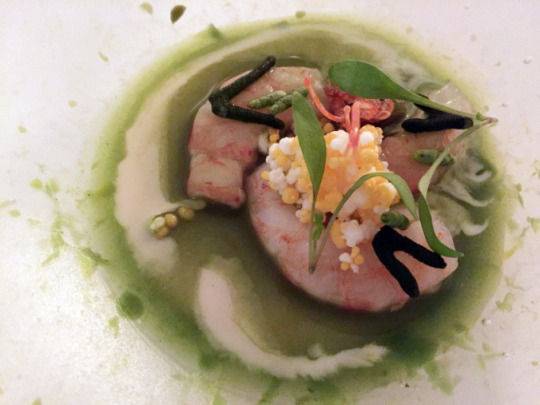
We had moved, oenologically, onto a new white wine, this time a glass of Anselmo Mendes Parcela Unica 2016, made from Alvarinho grapes. We got the expected peach, citrus and minerality from it, which went well with the shrimp, and also with the cuttlefish that was brought out next. These were tiny cuttlefish served two ways, with fried rice and with a gloriously unctuous spicy Hollandaise sauce. The first pieces were served an a plate possibly made from a dried cuttlefish, which just made me laugh…
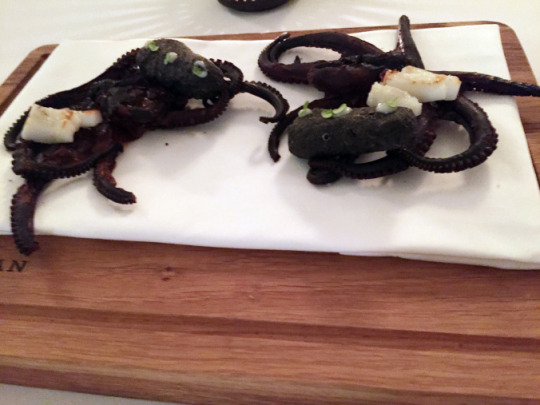
It also tasted good, especially dredged through the spicy Hollandaise sauce.
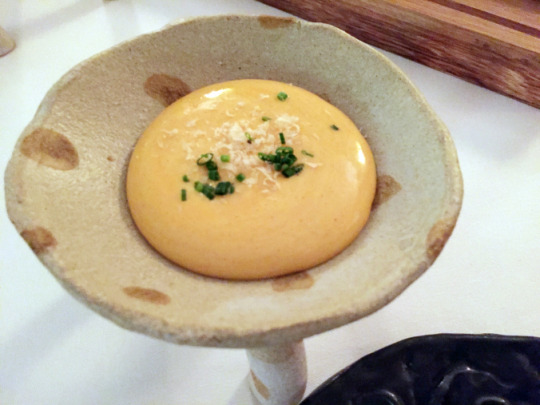
The other pieces came on a plate decorated with octopus shapes. It seemed a lot of trouble to go to, but then it’s that sort of place.
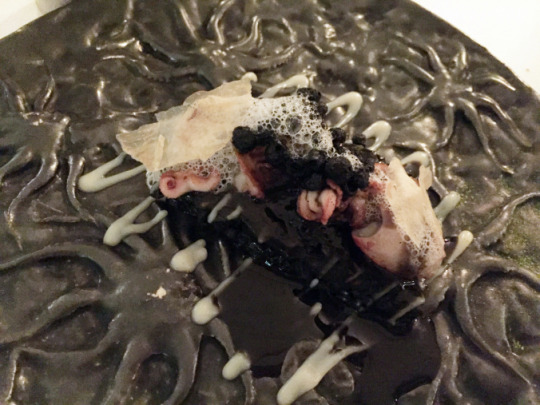
We knew we’d moved on from fish when the waiters brought us some butter in a very stylish box…

There was also a dish of olive oil, the oil a lovely shade of golden yellow that instantly made me want to dunk some bread in it.

That was made possible when the loaf of sourdough was put in front of us.

We had reached what would usually be the suckling pig course, but the restaurant swapped things round and served us the national beef first. It was a small but perfectly cooked piece, the iron of the rare meet working brilliantly with the roasted spring onion, the Jerusalem artichoke puree, and the rich, deep civet sauce. The meat would probably have fallen apart with just the application of a spoon, but we used our knives, cutting small pieces to try and make it last as long as possible. With it was drank a mighty fine, deep Maria João Private Collection 2008 from the Dão, and made possibly from Alfrocheiro, Aragonez, Touriga Nacional, and Jaen grapes (at least the 2010 was), with notes of chocolate, toasted cocoa, spices and dried red fruits that I definitely picked up.

If the beef and wine combination was good, the replacement for the suckling pig, which came next was sublime. It was the same accompaniments or mango, coconut and chilli, but served with two perfectly cooked pigeon breasts, the skin beautifully seasoned and crsip. We drank a Boavista Reserva 2015. I’ve seen the wine described as “deep ruby colour. Complex, deep, intense and seductive hints of both red and black fruit, plus tobacco, spices and dark chocolate”. I see no reason to disagree with that assessment.
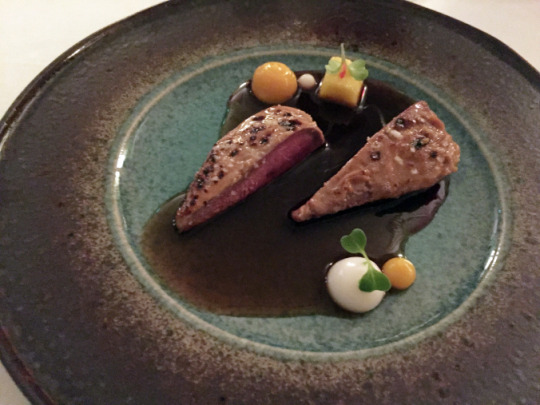
The last of the pigeon was gone, and it was on to the home straight for a dessert or two, starting with wild strawberries (in different textures), including a soup served in a wonderfully complicated drinking vessel. This definitely was essence of strawberries in all their wonderful forms, and it was a brilliant way to complete an excellent meal. Especially with a glass of Adega de Favaios Moscatel Colheita 1999, a sweet white moscatel instead of a port, but made with much the same levels of care, commitment and, dare I say it, obsession to create an ideal dessert wine. The Moscatel Galego grape produces a clear, bright, golden coloured wine, with citrus freshness and honeyed sweetness that matches fruit as well as chocolate. It’s a wonderful wine.

There was also São Tomé chocolate (with toasted corn, toffee, and whipped cream) which came along with the terrifyingly well-stocked petit fours trolley. We resisted the temptation of an offer to let us have a piece of everything on the trolley because I think we’d have needed to be put of trolleys to be taken out to the foyer if we’d done that.

I did weaken and have a tiny doughtnut, and a pastel de nata though, along with a cute little meringue.

We turned down the offer of infusions or coffee and were presented with a copy of the menu each in a lovely sealed envelope, along with a list of the wines we’d drunk. It was a lovely evening, and we were more than happy to get a taxi back to the Intercontinental instead of trying to walk to the metro (which would be doable, but who wantes to after a meal like that, right?)
Food 2019 – The Yeatman, Vila Nova de Gaia Sunday, 14th July 2019 - The Yeatman, Vila Nova de Gaia Sunday night was the blow out meal of the weekend, a 2 Michelin-starred tasting menu in what might be the best hotel in the area, …
#2019#Bars#Cocktails#Cooking#Dick&039;s Bar#Dinners#Drink#Europe#Food#Food and Drink#Hospitality#Hotels#Porto#Portugal#Restaurants#The Yeatman#Travel#Vila Nova de Gaia#Wine
1 note
·
View note
Text
September 9: Ansiao, Walking Day 9 - 19 km
1000 ft gross altitude gain
Great fun last night. After a beer and a haircut, we went back to the residencia for some blogging, R&R and tending to wounds. Just so everyone knows, I write the blog, but it is definitely a joint effort, with Kim suggesting additions, insisting on deletions and generally keeping my ego in check.
The restaurant attached to our accommodation had a huge sign saying it was closed until Sept 19, but the woman at reception asked whether we wanted meat or fish for “jantar” so we knew something would be worked out. Other guests were told to eat elsewhere and when we arrived at the restaurant at 19:00 we found a single table set for two in a place with room for 50 diners. The host very thoughtfully put the Potuguese version of “The Price is Right” on the widescreen TV next to our table in hopes it would appeal to our sophisticated tastes. After bread, olives and some of the best chicken soup ever, our grilled whitefish arrived perfectly cooked. It was accompanied by steamed yellow potatoes that melt in your mouth, a fantastic tomato and Valencia onion salad and a litre of Vino de la Casa. We staggered out at the end, completely satiated.

Awake at 5:30 because our neighbours had arisen early and felt it was essential to announce their accomplishment by yelling to one another in the hallway. A bit of a tough day for me as my blisters are fresh and they seem to take great joy in reminding me who is in charge of the walking pace. A really tough day for Kim as he had to listen to my incessant whining. Not much of historic or picturesque interest today except the many derelict buildings strewn across the country side (50 years old or 500?). There were also Passion flower vines that are largely in fruit, but still have a few lovely blossoms. Sorry, did not think to take a picture.

Rolled into town around noon and stopped for a cafe con leche and a french pastry larger than a deck of cards (total bill 3.20 €). Fabulous pastry and a lot less expensive than Starbucks.😄. Part way through our snack a woman came running across the square telling us that she was from the tourist office and “needed” to stamp our pilgrim credentials. When Kim politely asked her name, she said with a broad smile that she was Portugal’s Claudia Schiffer; just shorter, wider and she had died her hair from blonde to brown. She was from a town just 6km away that had suffered greatly since “some idiot” had moved the Camino trail. Today they are having a festival at the site of their extensive Roman ruins, but despite her pleadings, Kim and I simply don’t have the energy to trek there, even in a cab.

When we got to our hotel, our luggage had not arrived so we dropped our packs and headed into town for our first actual lunch since leaving Lisbon. We split a twelve inch Sicilian pizza with olives (pits in), onions, mushrooms and bacon. Now, normally when I have bacon on a pizza, I might expect five slices, but here it was five layers of bacon. My best guess is that one pizza had at least 3/4 of a pound of bacon and probably considerably more. Service was excellent from the single waiter (a bit of help serving from the cook) who was dealing with seating for about 80 that was almost entirely full. Together with a half litre of white wine from the tap and some mineral water 12€. This is where I point out that Kim and I will not be taking pictures of our food unless and until we stumble across a Michelin starred restaurant and probably not even then.

Despite the rain last night, the country remains parched. The Nabão River which rises here in Ansião (same river in Tomar), is absolutely bone dry. We have at least been fortunate enough to avoid the forest fires.

Well, an afternoon nap and dinner are all that we can see in our future, so adios until tomorrow (another 30 km plus day).
Norman & Kim
1 note
·
View note
Text
10 Terrific Ways to Use All Your Summer Tomatoes
When I was a kid, I would not eat tomatoes. I swore I hated them. Sure I would eat ketchup and tomato sauce, but not actual tomatoes. When I became vegan, everything changed. Suddenly, I learned to love lots of foods I wouldn’t eat before, and tomatoes were one of them. Currently, I eat tomatoes every single day in one form or another. They are one of the foods I cannot run out of or I feel lost and deprived. Summer is a great time for tomatoes. This is when they are at their best – deep red, juicy and intense in flavor. There are Beefsteaks, Roma Plums, Vine-Ripened, Grape, Cherry, Heirloom, and so many other types of tomatoes. Each has their own flavor and personality and each can be used in multiple ways.
You're reading: 10 Terrific Ways to Use All Your Summer Tomatoes
If you grow tomatoes, you will probably be swamped with them by the end of summer. Maybe you are the lucky recipient of someone who has too many to use or maybe you are indulging in the bounty of the farmers market. However you come by your tomatoes, now is the perfect time to try new and exciting things with them. Of course, you know you can use fresh tomatoes to make tomato sauce or salsa, and you know they taste great in salads and sandwiches. Well, here are 10 different ways to use all those beautiful summer tomatoes.
1. Make Homemade Bruschetta
Heirloom Tomato and White Bean Bruschetta
Tomatoes can have no better friends than fruity olive oil, savory garlic, and crispy bread. Bruschetta is a favorite appetizer or hors d’ouvres. I make a Garlic Tomato Bruschetta that is so good, that and a glass of white wine is all I need for dinner. Here’s how I make it: Preheat the broiler. Place thin slices of Italian, Ciabatta or French bread onto a baking sheet.
Drizzle extra-virgin olive oil over them and broil for just 3-4 minutes until they are crispy and golden brown. Remove the bread from the oven and set them aside. In a skillet, heat a spoon of extra-virgin olive oil over medium heat. Add 4 minced garlic cloves and a pinch of red pepper flakes and cook for a minute until the garlic starts to soften. Add 1 pint of halved grape tomatoes and toss in the seasoned oil. Cook for 4-5 minutes until the tomatoes soften. Season with salt and pepper and spoon the tomatoes onto the toasted bread. Garnish with fresh parsley or basil and vegan grated parmesan. Make a lot. This is addictive. Don’t say I didn’t warn you.
Read more: 10 Vegetables to Plant in the Fall and Winter That Will Withstand the Cold
2. Make Soup – Raw or Cooked
Gazpacho is a Spanish soup that is served cold. It’s also easy to make – just blend ripe tomatoes with any other produce you desire onions, cucumber, bell peppers and even watermelon. Chill it and enjoy it. It couldn’t be easier. This Raw Tomato Red Pepper Soup combines meaty tomatoes, sweet bell pepper and spicy chipotle for a refreshing and beautiful soup. If you prefer your tomato soup hot, try this traditional Quick and Rich Tomato Soup or this creamy Tomato Coconut Soup.
3. Make Stuffed Tomatoes
Usually, when we make stuffed dishes, we put tomatoes into the vegetable we are stuffing but how about stuffing the tomatoes themselves? All you have to do is hollow out the tomatoes and replace the pulp with your favorite fillings. Toss cherry tomatoes with olive oil, salt, and red pepper flakes, and then stuff them with your favorite spread or vegan cheese. Broil them until the cheese melts and the tomatoes soften about 2 minutes. Garnish with fresh herbs and impress your guests with this beautiful appetizer.
Larger tomatoes can be stuffed to make a healthy and delicious entrée or side dish. I hollow out large beefsteak tomatoes and stuff them with a mixture of sauteed mushrooms, spinach, quinoa and the pulp from the tomatoes. Place them in a baking dish, sprinkle a few bread crumbs atop each one and bake for 30 minutes. For a lighter dish, stuff the tomatoes with your favorite summer salads like this Chickpea Waldorf Salad or this Tempeh “Tuna” Salad. It’s refreshing and you get to eat the plate!
4. Make Your Own Dried Tomatoes
I love sun-dried tomatoes. They add a tangy flavor to dishes and make a great snack too. You can buy sun-dried tomatoes in the store but why not make your own? Whether you use a dehydrator, your oven or the sun, it’s easy to dry foods yourself. To make your own oven-dried tomatoes, halve ripe tomatoes lengthwise and scoop out the seeds. Line a baking sheet with foil or parchment paper and toss the tomatoes in olive oil, salt, and pepper. Set your oven on its lowest temperature (150 degrees) and let the tomatoes cook for eight hours or until they have shrunken. Then use your self-dried tomatoes to make Raw Lasagna with Cilantro Pesto, Sundried Tomatoes and Marinated Veggies, Quinoa with Secret Pesto and Sun-Dried Tomatoes and this beautiful Sun-dried Tomato Tart with Zucchini Hummus.
5. Make Fried Green Tomatoes
Red tomatoes shouldn’t have all the fun; green ones deserve love too. Unripe green tomatoes are the star of the southern dish, Fried Green Tomatoes. Because they are unripe, green tomatoes are firmer with less moisture which means they hold up to frying better. You could fry red tomatoes but if they are juicy, it could get messy. Simply slice the tomatoes, bread them and fry them. Try these Fried Green Beer Tomatoes which are coated with cornmeal and dark beer or my Cajun-flavored Fried Green Tomatoes with Red Pepper Aioli.
6. Make Roasted Tomatoes
Tomatoes are sweet but when you roast them, they get this intense, rich flavor that is savory and succulent. Roasted tomatoes are delicious on their own as a side dish or used in other recipes. Just place halved tomatoes on a baking sheet lined with foil or parchment paper and drizzle them with olive oil, salt and your favorite herbs and spices. You can roast them fast in a 425-degree oven for 20 minutes or slowly in a 250-degree oven for a couple of hours until they are collapsed and softened. Then enjoy them in dishes like this bowl of Miso Roasted Tomatoes with Spiralized Carrot Noodles and these Grilled Avocados with Roasted Tomatoes.
7. Make Pickled Tomatoes
Pickled and fermented foods are delicious with their unique tang and saltiness. We eat pickled cabbage as sauerkraut, pickled onions, carrots and other veggies as kimchi and pickled cucumbers as…well, pickles. So why not pickle tomatoes? It’s easy, they can last a long time, and you can eat them on sandwiches or in salads or on their own. To make pickled tomatoes: cook your favorite spices such as garlic, red pepper flakes, ginger, cumin or mustard seeds in some olive oil for just a minute or two to deepen their flavors. Add one cup of your favorite vinegar and ¼ cup sugar to the saucepan and cook over medium heat until the sugar dissolves, about 5 minutes. This is the brine. Add some salt and let the mixture cool. Take a sterilized jar and fill it with peeled, ripe tomatoes cut into wedges or whatever shape you desire. Pour the brine over the tomatoes. Be sure to leave about ½ inch of room at the top. Cover and refrigerate for several hours. The longer you let the tomatoes pickle in the brine, the better they will be.
8. Make Homemade Chile Sauce
Chile sauce is amazing. It’s rich, sweet, spicy and tangy all at the same time. It’s used in lots of recipes, especially Asian ones. You can buy bottles of chile sauce but some have ingredients such as high-fructose corn syrup and others can be expensive. When I ran out of chile sauce in the middle of making a recipe, I couldn’t substitute anything else so I learned to make my own. It was much simpler than I thought it would be and now I always make it myself.
Let me share my recipe with you: Combine 2 cups of fresh, pureed tomatoes (plums have the best flavor), ¼ cup tomato paste, ¼ cup apple cider vinegar, ¼ cup brown sugar, 2 chopped jalapeno peppers, 1 tsp. each garlic powder and chile powder, ½ tsp. each dry mustard powder and onion powder, a pinch of allspice, and 2 Tbs. vegan Worcestershire sauce in a food processor. If you don’t have vegan Worcestershire sauce, you can use 1 Tbs. each tamari and balsamic vinegar. Add a pinch of red pepper flakes if you want extra heat. Process until smooth and taste for any seasoning adjustments. Keep in a jar in the fridge and use it in recipes such as Braised Seitan Short Ribs in Spicy Chile Sauce, Mississippi Comeback Sauce and Sesame Tofu.
Read more: Create a Beautiful Garden Bed with These Edging Ideas
9. Make Tomato Desserts
Yes, desserts. We use spinach, avocado, and zucchini in desserts so why not tomatoes? After all, tomatoes are a fruit and with more recipes mixing sweet and savory tastes, tomatoes are a perfect ingredient for desserts. The next time you go to make your own ice cream or sorbet, consider giving tomatoes a try by either adding one or two to the recipe or going totally tomato-flavored. Add some little tomato wedges to fruit cocktail or these Raw Fruit Tartlets. Their gentle flavor mingles well with strawberries, watermelon, pineapple, mango, pears, melon and berries. Garnish your tomato dessert with fresh mint or basil leaves.
10. Freeze Your Tomatoes
Even though you can buy tomatoes year round, they are only in season for a short time. Or perhaps, you grew so many tomatoes, you can’t possibly use them all, no matter how many tomato ideas and recipes I give you. Well, the good news is that you can freeze tomatoes so you can enjoy them all year long. Tomatoes can be frozen with their skins or peeled, raw or cooked, whole, chopped, sliced or pureed. If you make tomato soup or sauce, you can also freeze the prepared foods.
To freeze tomatoes, select ones that are ripe and firm. Wash them gently and blot them dry. Prepare the tomatoes by cutting them into the desired shape and place them in a single layer on a cookie sheet that will fit in your freezer. After they are frozen, transfer the tomatoes to freezer bags or sealed storage containers. When you need them, just thaw them out and use them in any cooked recipe (thawed tomatoes will be too mushy to eat like you would a fresh tomato). Frozen tomatoes can last up to 8 months so you can be enjoying summer tomatoes in the middle of a winter snowstorm.
There is no food more versatile than the tomato. Sweet or savory, raw or cooked, alone or as part of a recipe, tomatoes are nature’s candy. I hope you have fun trying these ways of using your summer tomato bounty and if you have any bushels leftover, send them my way.
We also highly recommend downloading our Food Monster App , which is available for iPhone , and can also be found on Instagram and Facebook . The app has more than 15,000 plant-based, allergy-friendly recipes, and subscribers gain access to new recipes every day. Check it out!
For more Vegan Food, Health, Recipe, Animal, and Life content published daily, don’t forget to subscribe to the One Green Planet Newsletter !
Being publicly-funded gives us a greater chance to continue providing you with high quality content. Please support us !
Source: https://livingcorner.com.au Category: Garden
source https://livingcorner.com.au/10-terrific-ways-to-use-all-your-summer-tomatoes/
0 notes
Text
Recipes to follow at the bottom.
Roasted Chicken with Oranges, Brussels Sprouts, and Green Olives
Stuffed Artichokes
Butternut Squash Soup
Fruit Salad
Macaron Tree
Can-died Pears
Crimson Thread and Menage Trois wines
Reading The Handmaid’s Tale by Margaret Atwood, I was a bit daunted by how to create a menu in theme with the book. In a dystopian society, what do they eat? How do they eat? How do they cook? Thankfully, Miss Anya Spector came to my rescue. “Why don’t we do a Birth Day Party?” Duh. A Birth Day Party. Though this is an oppressive society, they seem to splurge when it comes to the day their Handmaid’s gave birth. This fact opened up options for me. Here, I want to explain my research, as well as my choices for the menu for this week. The three stages in this process are as follows: research, prep, and cooking.
1. Research
The background of the book is a bit vague. We don’t really learn what happened to the US until page 174 of the Anchor Books edition. I tried to mark down any mention of food, but I also found a list on the website Bookmenus.com. There were many foods mentioned, but the most mentioned were oranges and coffee. Because Anya Spector and I live on coffee, this would automatically make the menu. It is now tradition to begin a recording session with a strong cup. Oranges, however, stumped me. I knew we should do a luncheon, but what savory options would be included?
That’s when I found an interview with the production crew of the new Hulu TV adaptation. A lot of research went into making decisions of what to include in grocery stores like Loves and Fishes in the show. Production designer Julie Berghoff said to a Marie Clare writer visiting set, “Every piece of fruit had a thought process behind it—when she gets oranges, the implication is, ‘Okay, they conquered Florida.’ If they had artichokes, it meant they conquered California. The evolution of Gilead was always in mind.” So that was it. Oranges and artichokes were enough inspiration to start a menu.
In Gilead, there seems to be a black market where rich wives can find luxury gifts, from cosmetics and lotions, to exotic cheeses and canned goods. Following the logic of Berghoff, assuming Florida and California had been conquered, and the Marthas had access to their agriculture, as well as some black market items, they could create a bountiful Birth Day banquet, fit for a Gilead luncheon.
One thing that stood out to me in the books was that cooking had become a bit more pure. No longer are there processed, pre-made foods in Gilead. Everything is homemade, so that was something that we wanted to emphasize in our own work… Not that we’ve actually served anything store bought other than the Harry Potter Candy. However, the homemade bread from P&P, and homemade macarons are very different. Everything to follow is made by us.
2. Preperation
Because I agreed to make quite a big spread for this book, my preparation began days before our actual recording. Quick tip: most soups can be made in advance and frozen! Almost all soups have a base that can be separated and frozen, while garnish can be made the day-of.
So I made the soup first. Butternut squash is hard, so make sure you have a sharp knife, sharp peeler, and strong grip. When roasting, make sure you dice vegetables as uniform as possible for even cooking. Metal spoons work wonders at scraping out squash. Save the pulp for a squash bread, especially pumpkins. The seeds can be roasted and salted for a healthy snack! When roasting the squash (see recipe below) toss roasting vegetables in the combination canola oil and EVOO. This mixture lowers the smoke point and help avoid over caramelizing the vegetables. Then I place a small piece of butter at each end of the roasting sheet for the nutty browned butter flavor. Finally, just barely cover the roasted vegetables with vegetable broth. You can always add more, you can’t take it out. However, if your soup becomes more like a puree, thin with more broth. Remember the more you thin, the less seasoning it will have so be sure to continue to taste. Separate into servings and freeze for freshest taste. Thaw the morning-of.
Next I prepped the artichokes. Artichokes have a low yield, so we try our best to avoid cutting the yield down further by wasting much of the plant. Cut the stems off to make the artichokes sit flat on a cutting board. Next cut tips off, at least an inch and a half down the artichoke. Trim the other untrimmed leaves with kitchen sears. Soak in water with fresh squeezed lemons, and be sure to rub the leaves and stem in lemon to prevent discoloration. I’m soaking mine for half a day. When they are done, I will steam them until the are tender, around half an hour. The day of the book club meeting, I will stuff them and roast them.
For the chicken, the oranges can be sliced the day before. Beware! You will smell like oranges all damn day. The Brussels Sprouts can also be cleaned. I tear the outside leaves off the sprouts, cut the stems off, and slice them in half. Store in water and lemon to prevent discoloration. The chicken can also be cleaned and trussed the night before. Run under cold water, and pat dry. Stuff with garlic cloves, onion halves, lemon and orange halves. Truss chicken to prevent the stuffing falling out. Rub in butter. Salt and pepper the chicken just before it is cooked. Pan sear for a beautiful golden brown color. For the gravy, make sure you pre-make the veloute base (blonde roux with stock, reduce until thickened. Skim the scum it creates to reduce floury flavor!). Mix veloute base with drippings and reduce.
Finally the fruit. For your fruit salad, make sure you have a good arrangement of fruit. Too many tart fruits together will make your mouth turn inside out (i.e. pineapple, oranges, grapes, green apples, raspberries…). Instead, mix with softer flavors like strawberries, red apples, melons, etc. For the “can”-died pears, we’re using canned fruit so it is already soft. Don’t overcook these, or they will turn to mush. You only want to heat these up. Immediately mix in the butter with spices. Finish with the whiskey. Be careful! Any time you are cooking with a high-alcohol content liquor, there is a chance it will go up in flames! This is called flambe. Don’t panic if it happens. Enjoy the pretty colors! Alcohol burns off very quickly. As long as it stays in the pan, you are safe. If you try to fling it into the sink, you risk spilling it on something that will actually catch fire. Instead, tend it carefully and it will go out.
**Macaron vs Macaroon
Okay let us get one thing straight. There is a difference between these two cookies, so let me educate y’all. For this podcast, Hale graciously cooked us macarons and we put them on a painted foam tree for pictures. However, many people will think they are macaroons, which would be untrue. Many of you may know the double-O Macaroon. This meringue cookie is popular in the US during Passover, and to understand that you need to understand the history of the cookie and how the French macaron became the coconut macaroon you find in cookie tins.
So the “French” Macaron actually came from Sicily (shout out to my fellow Sicilian co-host Hale). Macaron is actually related to the Italian word ammaccare, meaning “to crush.” This relationship probably refers to the act of crushing almonds into powder, the process necessary for your perfect French Macaron. However, until the 18th century, the cooks in the United States could not get their hands on many nuts or nut powders. Instead they substituted potato starch for a bit of texture, and substituted coconuts for almonds or other nuts, which were more perishable. Because the cookie has no leavening agent, they are considered acceptable for Passover! Thus, we have tins of chocolate dipped coconut macaroons for Passover in the US! However similar in history these cookies are, in the 18th century with the rise of French cuisine, these cookies deviated from each other. Though both are egg white meringue based cookies, the “flour” used is quite different. The French style is said to be more tedious and particular. Below you will see the difference between the coconut macaroon and the French macaron, respectively.
3. Cooking and Final Product
Roasted Chicken with Oranges, Olives, and Brussels Sprouts:
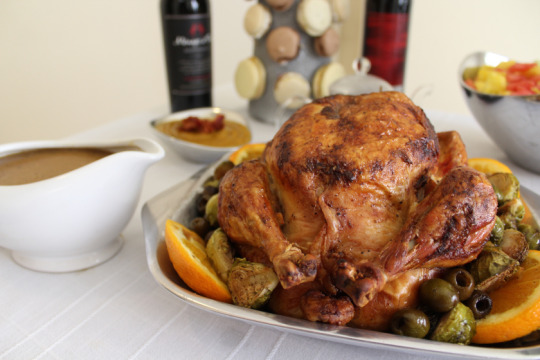
Ingredients:
Whole chicken (for 3-4 people)
3 Oranges
2 Cans Olives
1 lb Bussels Sprouts halved
1 Small Onion
Butter/Oil
Salt and Pepper to Taste
Process:
Preheat oven to 400
Clean, stuff, and truss chicken, salt and pepper to taste with a bit of butter rubbed over it
Line greased pan with oranges, halved Brussels sprouts, and green olives
Place chicken on top
Mix orange juice and honey and pour over chicken and everything on roasting tray
Roast in oven until done; start checking around the hour point.
When the chicken comes out of the oven, save drippings.
Mix drippings with veloute sauce. Reduce to desired thickness. Season with salt and pepper, orange juice if needed.
If the sauce isn’t thick enough, add a corn starch slurry
Fruit Salad
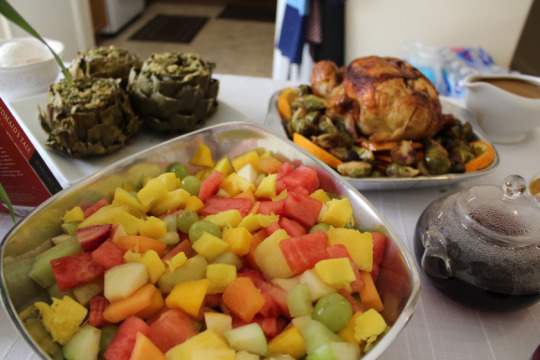
Banana, Papaya, Oranges, Grapes, Watermelon, Honeydew, Cantaloupe, Mango
Cut uniformly and serve
Butternut Squash Soup:
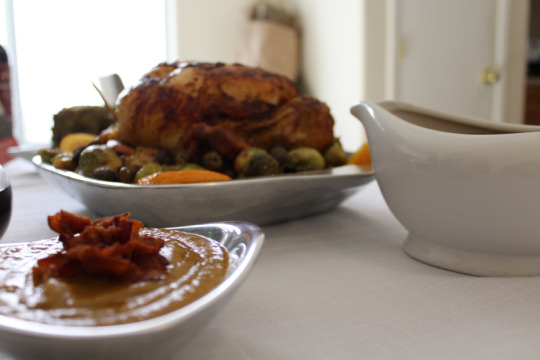
Cubed squash oiled on a roasting tray with salt and pepper, nutmeg, cinnamon, allspice, rubbed sage, rosemary, and thyme
Roast at 400 until tender, about 30 mins
Puree with warm vegetable stock to desired thickness
Season to taste
Garnish with bacon lardons
“Can”-died Pears:
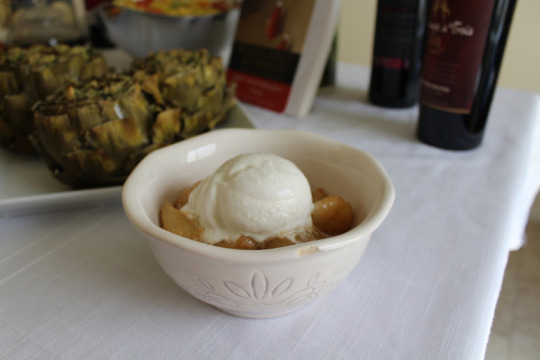
Canned pears quartered sautéed with butter and cinnamon/nutmeg
Saute in butter until they turn golden, mix in brown sugar
Finish with honey whiskey–flambe
Top with ice cream
Stuffed Artichoke:
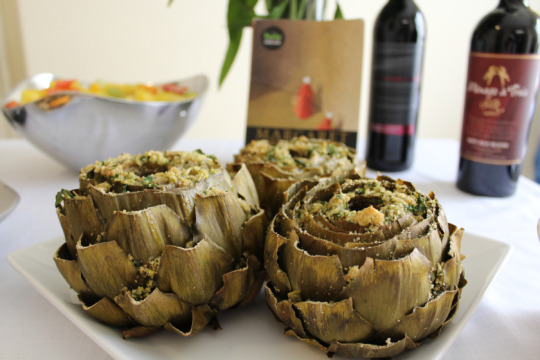
Ingredients:
3 large Artichokes (for 4-6 people)
Lemons
1 cup Italian Style Bread Crumbs
8-10 Garlic Cloves, chopped
1/2 cup Parsley, Basil chopped
1/2 cup Grated Parmesan Cheese
1/2 cup Grated Romano Cheese
Butter/Oil
Process:
Clean artichoke, soak, steam until tender (see tips above)
Mix together breadcrumbs, garlic, herbs, cheese, and melted butter or oil
Spoon mixture between leaves of artichoke
Roast until brown at about 375 degrees
Macarons (not Macaroons. See note)

For the macaron shells:
300g ground almonds
300g powdered sugar
110g liquefied egg whites (see below)
+ 300g caster sugar
75g water
110g liquefied egg whites
Liquid food dye to splatter: pink, blue and yellow
Frosting:
1 batch fluffy vanilla buttercream frosting
1 drop each of yellow, green, blue, purple, red and orange food gel
Process:
For the process, use the directions the creator of this recipe uses. Follow the link below.
https://www.thescranline.com/yay-gay-macarons
For a butter cream recipe, look to our Harry Potter themed birthday cake from last months’ recipes: https://loadedliteraturepodcast.com/2018/07/04/unicorn-blood-and-candy/
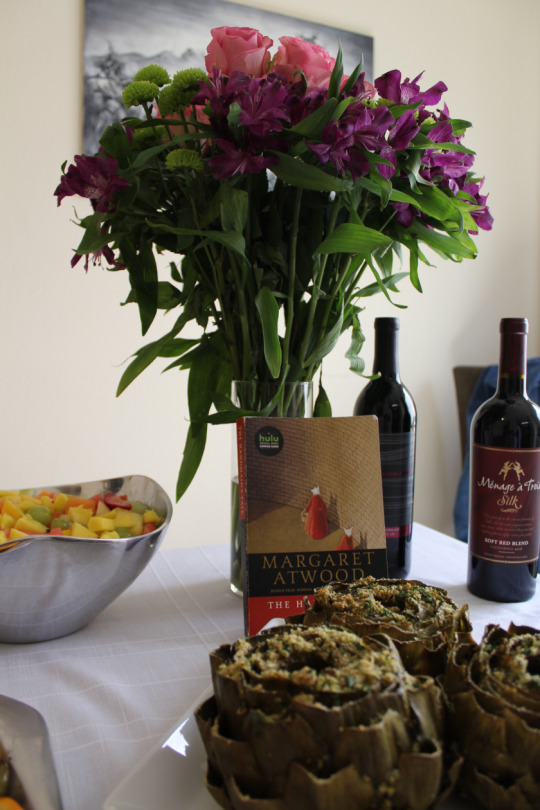
Macaron vs Macaroon; or Forever Smelling of Oranges Recipes to follow at the bottom. Roasted Chicken with Oranges, Brussels Sprouts, and Green Olives Stuffed Artichokes…
#Birth Day#Butternut Squash#Butternut Squash Soup#Candied Pears#Fruit Salad#Handmaid&039;s Tale#Macaron#Macaroon#Recipes#Red Wine#Roast chicken with Brussels Sprouts#Roast Chicken with Green Olives#Roast chicken with oranges#Stuffed Artichokes
1 note
·
View note
Text
Brian Minter: Edible perennials that can survive the winter chill

For those folks anxious to get some early vegetables on the go, Mother Nature just gave us a less-than-subtle reminder that she’s the one in charge of garden timing.
The recent cold spell should also make us more aware than ever that all cool-loving veggies, like onions, peas and radishes, are best planted when daytime temperatures are consistently 10 C or higher. There are, however, a few edible perennials that can go in our gardens even before we hit that 10 C threshold.
Horseradish, a very hardy garden staple in the cruciferae family, has long been used to add spice to many of our foods. Native to Eastern Europe, Russia and Finland, early colonists brought it to the Americas, where it managed to escape out of those early gardens and into the wild, becoming a somewhat invasive intruder.
It’s a little more civilized today.
At this time of year, horseradish is available as root divisions. Plant them a foot apart with the thin end down and the top about three inches below the soil line. Planted now, they will mature by fall, at which time the outside roots can be harvested, leaving the centre root in place for continuous production. The most rapid growth takes place in late summer and once established, horseradish can be harvested year-round.
To use them, grate the roots into white wine vinegar for immediate use, or if bottled and refrigerated, it will keep for weeks. For longer-term storage, grate and dry the roots into a powder before bottling.
Enjoyed fresh, however, is when horseradish is best and most pungent, adding a special zing to meats, like roast beef, and even to seafood sauces.
Related to sunflowers, the so-called Jerusalem artichoke (Helianthus tuberosus) is probably the least familiar perennial vegetable. Native to eastern North America, it has no relationship whatsoever with the actual globe artichokes we all know and love. Early North American explorers took some back to Europe in the 1600s. The French named them the ‘artichaut du Canada’. These very hardy, knobby little tubers spread rather quickly, to the point of being invasive. Planted about four inches deep, the tubers send up sunflower-like stalks that measure six-to-10 feet tall and produce three-inch flowers.
After about 100 days, the tubers can be harvested. In terms of preparation, they have many similarities to potatoes, but they should never be cooked too long for fear of making them too tough to eat. Most folks slice them finely into salads or use them as a garnish in clear soups. Boiled for about 15 minutes, they become quite tender and are especially nice served with an oil and vinegar dressing. At this stage, they can also be sauteed in butter for a wonderful treat. These tubers are starch-free, and because their carbohydrates don’t convert to sugar, they can be enjoyed by folks with diabetes.
True globe artichokes can be started soon from seed, and they’ll still have time to produce beautiful, edible, flowering seed pods. These tender perennials (rated Zone 8) can be grown in colder climates (down to Zone 6) as long as they have good winter protection. Once established, they’ll produce year-after-year.
The ancient Romans were among the first to enjoy this unique edible thistle. After the collapse of the Roman Empire, the Medici family in Florence introduced these gourmet delicacies to the French.
Both French and Spanish explorers brought them to North America. If you have ever travelled through the agricultural areas between San Francisco and Santa Barbara, especially during September through to May, you’ll see hundreds of acres of artichokes under cultivation. They make quite a spectacular sight.
Most folks start with mature plants when the temperature warms up in mid-April to mid-May. Within one growing season, these large, three-to-four-foot plants will each produce three-to-five thistle-like heads that will be ready to harvest in late summer when they’re tight and plump. Boiled or steamed for about 45 minutes, they can be served hot or cold. The leaves, pulled off one at a time and dipped in a sauce or melted butter, are then eaten by pulling each leaf through your teeth to extract the delicious, pulpy contents. Once all the leaves have been enjoyed, scrape away the fuzzy centre and enjoy the heart of the artichoke with any number of herb sauces.
In our area, once artichoke heads are harvested, cut the stalk down to about one foot, and as winter approaches, protect the plant well with a combination of mulch and evergreen branches. Always locate artichoke plants in the sunniest area of the garden, out of cold winter winds.
Now is the time to plant long-lived rhubarb, the most well-known and most popular perennial vegetable. Rhubarb can be purchased either as rhizome clumps or as started plants. Started plants will save at least one year in terms of when they can be harvested. Rhubarb needs space because one plant can grow about three feet across. Most folks plant a single clump, but for a larger family, three plants will usually suffice.
Some of the best rhubarb varieties are Canada Red, Victoria, Crimson Cherry, McDonald and Valentine Red. Younger, thinner stems can simply be chopped into small chunks, while older, thick stems may need to be peeled before cooking or steaming. Rhubarb is predominately used for desserts, such as rhubarb pie, which is a classic, or combined with a variety of berries to make great jams, jellies and fruit compotes.
Asparagus is a highly prized perennial vegetable. Although it takes three years from seed to come into production, its roots continue to produce for at least 15 years. Starting with established one- or two-year-old roots will save at least one year of growing time. ‘Mary Washington’ is a traditional old favourite. Newer hybrids, like ‘Jersey Knight’, produce larger crops of big, attractive green spears with purple bracts and tips. ‘Millennium’ is one of the most productive yet. The spears of ‘Sweet Purple’ have a 20 per cent higher sugar content and are usually eaten raw. ‘Rhapsody’ is a delicious white variety. Once established, the spears must be covered with soil to keep them pure white.
Asparagus needs a sunny, well-draining location with slightly alkaline soil. Planting involves trenches dug four feet apart, 12 inches wide and 12-to-18 inches deep. Each trench bottom is filled with a mound of soil mixed with well-composted manure. The top of the mound should be three-to-four inches below ground level.
The roots are laid on top of the mound, pointing straight down, 18 inches apart and spread evenly on both sides. The trench is backfilled, leaving the tips of the asparagus just barely covered. Root growth begins almost immediately, although it will take a year for the roots to become well-established.
The second year after planting, harvest a few spears for up to six weeks. When the spears are six-to-eight inches high, cut them at a 45 degree angle about 1 1/2 inches below the soil line — be careful not to damage the crowns.
If any spears get away on you, let them develop into foliage. Once the spears become very thin, stop cutting. Let the plumes grow all summer. In colder parts of B.C., leave them standing to trap snow for better winter protection. In the Lower Mainland, cut the plumes off in September when the seed pods start to form and cover the roots with four inches of coarse manure.
All these edible perennials are a real treat in any garden, and as our growing season begins soon, try to find a home for some or all of them for years of enjoyment.
Brian Minter: Edible perennials that can survive the winter chill published first on https://weedkillerguide.tumblr.com/
0 notes
Text
Foods of Russia

In short, Russian cuisine can be divided into four main eras:
Old Russian cuisine (9th-16th centuries);
In the medieval period most Russian beverages turned national: mead, khmel, kvass, cider. Beer appeared in 1284. In 1440-1470s Russia discovered vodka made from rye grain. Until the 17th century milk and meat were not popular. Meat boiled in shchi (cabbage soup) or for kasha was not even roasted until the 16th century.
Old Moscow cuisine (17th century):
Starting with Peter the Great, Russian nobility borrowed some of West European culinary customs and traditions. Rich nobles who visited countries in Western Europe brought foreign chefs with them to expand their repertoire. It was at this time that minced meat was introduced into Russian cuisine: chops, casseroles, pates and rolls became quite popular, along with non-Russian (Swedish, German, French) soups, which appeared in the 17th century: solyanka, (beef soup) and rassolnik (potato and pickle soup) containing brines, lemons and olives appeared at the same time and were hppily integrated into the cuisine. It was during this period that such well-known delicacies as black caviar and salted, jellied fish appeared.
In the 16th century Kazan and Astrakhan Khanates along with Bashkiria and Siberia were annexed to Russia. New food products such as raisins (grapes), dried apricots, figs, melons, watermelons, lemons and tea made their first appearance, much to the delight of the populace. During the short growing season, even poor farmers could enjoy a variety of fresh fruits, along with drying them for the long winter months. Foreign chefs cooked their national dishes, which harmoniously fitted in Russian cuisine. There was also the time of German sandwiches, butter, French and Dutch cheeses.
Petersburg cuisine (end of the 18th century-1860s)
The French expanded the assortment of starters by adding a number of old Russian meat, fish, mushroom and sour vegetable dishes the variety of which can be a surprise for foreigners. Because cold weather could last as long as nine months in some regions, preserved foods were a large part of Russian cuisine, and households would store as much food as possible to last through the long winters. This included smoking, salting, soaking, and fermenting. Cabbage could be used all winter to make shchi, or be used as a filling for dumplings. Soaked apples were often served to guests or in some side dishes. Pickled cucumbers were a main ingredient in many dishes, including several traditional soups. Salted and dried meat and fish were eaten after religious and pre-holiday fasts. Overall, it was a pretty spartan diet, with most economic groups using what was available.
Traditional Russian foods are heavily influenced by filled dumplings, hearty stews, soups, potatoes and cabbage:
+Borscht one of Russia's best-known foods, a chunky, cold stew made with beets and topped with sour cream
+Beef Stroganoff - strips of beef sauteed in a sauce of butter, white wine, sour cream (called 'smetana' in Russia), mustard and onions; eaten either straight or poured over rice or noodles
+Sweet-and-Sour Cabbage - cooked in red wine vinegar, applesauce, butter and onions.diced apples, sugar, bay leaves
+Solyanka Soup - a hearty soup made from thick chunks of beef and/or pork, cooked for hours over a low flame with garlic, tomatoes, peppers and carrots
+Golubtsy.- Shredded or minced beef wrapped in cabbage and steamed/boiled until cooked; found all over Eastern Europe
+Olivie. - a kind of potato salad made with pickles, eggs, bologna and carrots mixed with mayo
+Blini - thin, crepe-like pancakces topped with savory or sweet toppings like minced beef, caviar, or apples
+Potato Okroshka.- cold soup made from buttermilk, potatoes and onions, garnished with dill; Vichyssoise (often attributed to the French, it was actually created at the Ritz Carlton in NYC in 1917 but of course disputed by French chefs, who insist they created it)
+Knish - mashed potatoes, ground beef, onions and cheese filled inside thick dough pastry and deep fried/baked
+Khinkali - dumplings of ground beef and cilantro
+Khachapuri - thick, crusty bread shaped like a boat and filled with a variety of melted cheese
+Zharkoye - a beef stew made with potatoes, carrots, parsley, and celery, spiced with garlic, cloves, and dill; served hot with sour cream
+Pelmeni - dumplings made from thin, unleavened dough, filled with minced meat, mushrooms and onions
+Shashlik - classic shesh kebab
+Tula Gingerbread - similar to our gingerbread, but may contain jam or nuts
+Pirozhki - pastries filled with meat, potatoes, cabbage or cheese, similar to Polish pierogi
+Morozhenoe (rich ice cream); well hey... now you're talkin'
+Chak-Chak (Russia's attempt at funnel cakes... would we make that up?)
You'll notice a distinct absence of fresh vegetable salads, seafood, pasta and rice.They are just not part of their basic diet. And of course Russia is certainly not known for their desserts. Even Chicken Kiev is generally credited to several NYC restaurants who claim they created it, not to any native Russian chef or restaurant. (gee... you can't believe anything these days).
So next time you get a hankering for some borscht or a kinkali, you just may have to whip it up yourself. There is not a preponderance of Russian restaurants anywhere in the U.S. nor the desire for them. Few people thnk of blinis or knish when planning Sunday dinner. But who knows? You might just discover a whole new world of cuisine when you stick your toe in the Russian diet (oh dear, that didn't come out right). Go for it.
1 note
·
View note
Text
Braised Chicken Recipes | Serious Eats

There are dozens of ways to cook chicken, but one of our favorite methods might be the simple-yet-mighty braise. From the French brazier, it’s a cooking technique in which meat is seared and then simmered slowly in a broth or sauce. From tinga tacos, in which chicken is stewed in a smoky chipotle and tomato-based sauce to coq au vin, which uses the whole bird for maximum flavor, this low and slow method is favored around the world—and for good reason. Not only does it produce fork-tender meat, but it’s also relatively hands-off and easy to master. Plus, ingredients for braising are easily found in the pantry. Wine, vinegar, canned tomatoes, broth, and even dried beans can all be building blocks to an amazing braise. Just pull out your favorite pot, sear the chicken to attain that crackly, potato chip-like chicken skin, add just enough liquid, and let your stove or oven do the rest. To speed up the process, you can also use a pressure cooker (or Instant Pot), which can cut the cooking time in half.
Easy One-Pot Chicken Tinga (Spicy Mexican Shredded Chicken)
[Photograph: J. Kenji López-Alt]
Stewed in tomatillos, tomatoes, and chipotle chilies, this chicken tinga is flavorful and versatile. Once it’s cooked, spoon the shredded chicken on top of a bed of nachos, inside an enchilada or burrito, or next to a pile of freshly warmed tortillas.
Easy One-Pot Chicken Tinga (Spicy Mexican Shredded Chicken) Recipe »
Back to the full list
Crispy Braised Chicken Thighs With Cabbage and Bacon
[Photograph: J. Kenji López-Alt]
Most braised meats lose their crisp exterior, but in this unique recipe, chicken thighs are seared, simmered atop a bed of bacon and cabbage, and then roasted with their skin exposed, which results in tender meat and crackly chicken skin. It all comes together in one pan in just over an hour.
Crispy Braised Chicken Thighs With Cabbage and Bacon Recipe »
Back to the full list
Black Bean Soup With Chorizo and Braised Chicken
[Photograph: J. Kenji Lopez-Alt]
Toss dried beans, chipotle chilies, chorizo, and drumsticks (or thighs) into Dutch oven for a quick and flavorful mostly hands-off braise. Even more hands off? This Black Bean Soup With Chorizo and Braised Chicken Recipe »
Back to the full list
Coq au Vin (Chicken Braised in Red Wine)
[Photograph: Daniel Gritzer]
Tackling coq au vin doesn’t necessarily mean braising a tough, older bird all day. In this recipe, the chicken breasts are added toward the end of the braising process to ensure they don’t dry out. But don’t worry, this late addition will still absorb all the benefits of the red wine, mushroom, lardon, and onion broth.
Coq au Vin (Chicken Braised in Red Wine) Recipe »
Back to the full list
Traditional French Cassoulet
[Photograph: J. Kenji Lopez-Alt]
Instead of relegating beans to a side dish, this quintessential Southern French dish puts beans front and center. Chicken fills in for the traditional duck, and garlic sausage and salt pork add even more flavor.
Traditional French Cassoulet Recipe »
Back to the full list
Spicy Chicken Tacos With Corn, Feta, and Avocado
[Photograph: Yasmin Fahr]
Use up that open can of chipotle adobo in your fridge for spicy, 20-minute chicken tacos. To balance the burn, add a dollop of corn and feta cheese salad (yes, we said feta) and slices of avocado.
Spicy Chicken Tacos With Corn, Feta, and Avocado Recipe »
Back to the full list
Taiwanese Three Cup Chicken (San Bei Ji)
[Photograph: Cathy Erway]
This classic Taiwanese recipe draws on a simple base of ingredients for its dark broth—soy sauce, rice wine, and sesame oil—punched up with a handful of garlic cloves and ginger slices.
Taiwanese Three Cup Chicken (San Bei Ji) Recipe »
Back to the full list
Chicken Cacciatore With Red Peppers, Tomato, and Onion
[Photograph: Vicky Wasik]
Sure, this recipe may not be the same as nonna’s, but what we love about cacciatore is how flexible it can be. Swapping duck for chicken drumsticks, this rustic stew keeps it simple with a tomato-based broth that’s spiked with white wine.
Chicken Cacciatore With Red Peppers, Tomato, and Onion Recipe »
Back to the full list
Filipino-Style Chicken Adobo
[Photograph: Vicky Wasik]
Fragrant and pungent, Filipino adobo needs to be in your weekly rotation. Bone-in chicken thighs or drumsticks find flavor in a marinade of equal parts soy sauce and vinegar, plus garlic, whole black peppercorns, and a few springs of bay. Planning out meals for the rest of the week? Let this marinade work its magic over night; it only gets better with time.
Filipino-Style Chicken Adobo Recipe »
Back to the full list
The Best Chicken Paprikash
[Photograph: J. Kenji Lopez-Alt]
Any combination of caramelized onions, tangy sour cream, and high-quality Hungarian sweet paprika makes for a solid chicken paprikash. But with little sear on the chicken plus an added hit of fish sauce and lemon juice for brightness, this Hungarian classic gets a well-deserved boost.
The Best Chicken Paprikash Recipe »
Back to the full list
Coconut- and Ají Amarillo–Braised Chicken
[Photograph: Vicky Wasik]
Chili aficionados know that there is much more to peppers than blinding heat. The ají amarillo, for example. Popular in Peru, this bright orange pepper tastes both fruity and floral. Curious about the heat but don’t want to get burned? A generous pour of coconut milk tempers the heat with a tropical finish.
Coconut- and Ají Amarillo–Braised Chicken Recipe »
Back to the full list
Chicken Scarpariello (Braised Chicken With Sausage and Peppers)
[Photograph: J. Kenji López-Alt]
In this version of pollo allo scarpariello—”shoemaker’s chicken”—skin-on chicken thighs are seared and then simmered in a sauce enriched with sausage and brightened with pickled cherry peppers. Adding some of the pickling liquid from the jar of peppers gives the sauce a nice balance of sweet and sour.
Chicken Scarpariello (Braised Chicken With Sausage and Peppers) Recipe »
Back to the full list
All products linked here have been independently selected by our editors. We may earn a commission on purchases, as described in our affiliate policy.
Source link
Tags: Braised, Chicken, Eats, Recipes
from WordPress https://ift.tt/354FA07 via IFTTT
1 note
·
View note